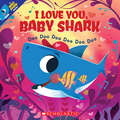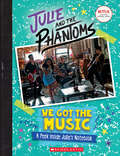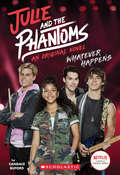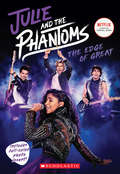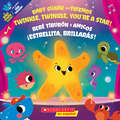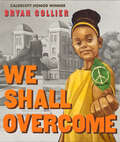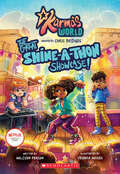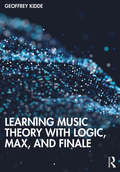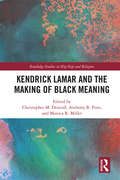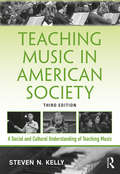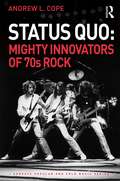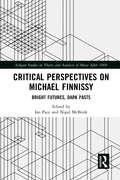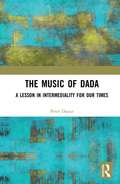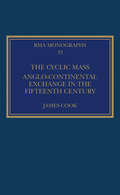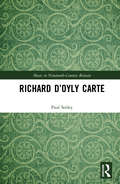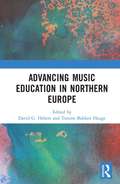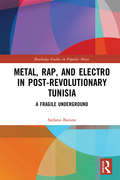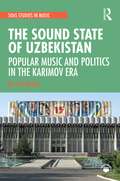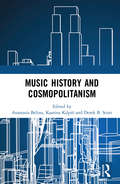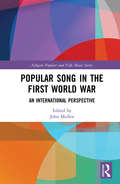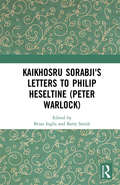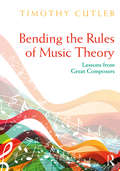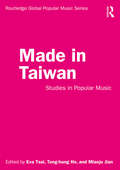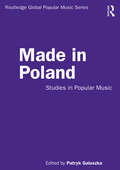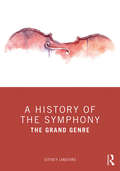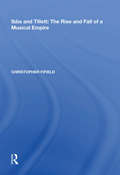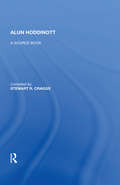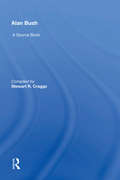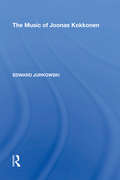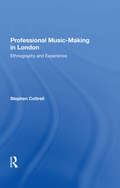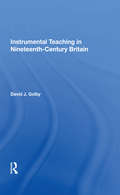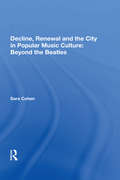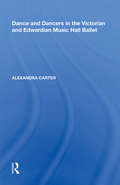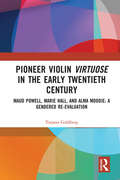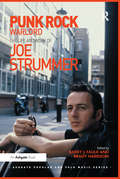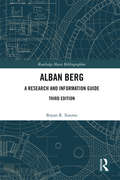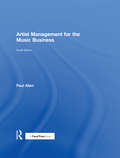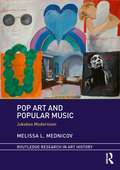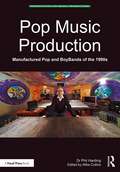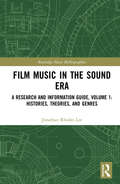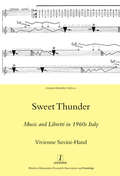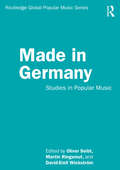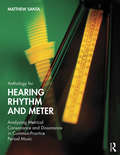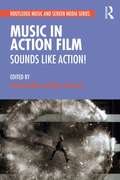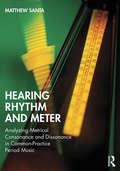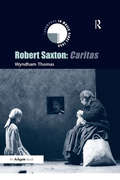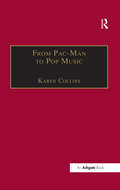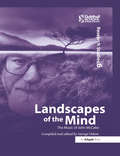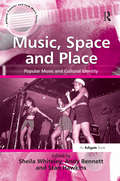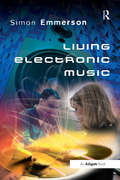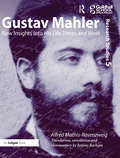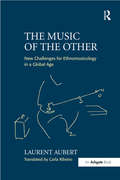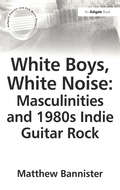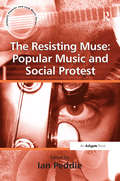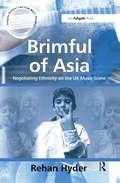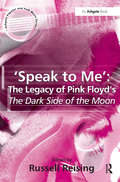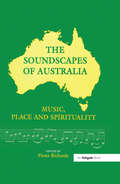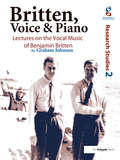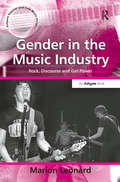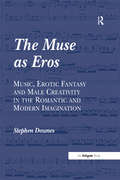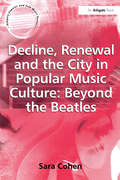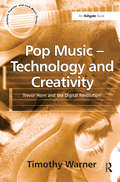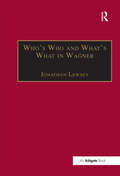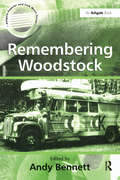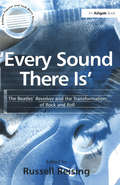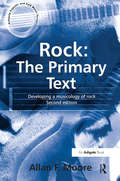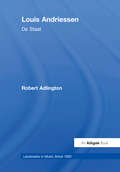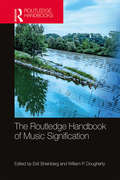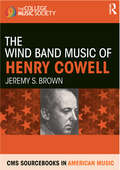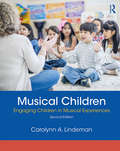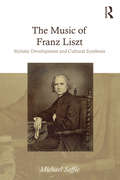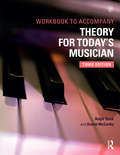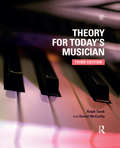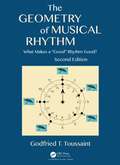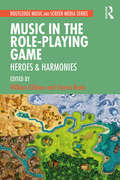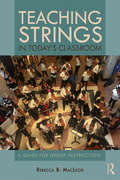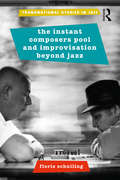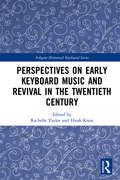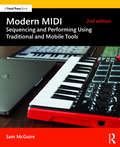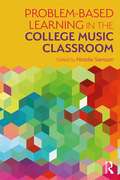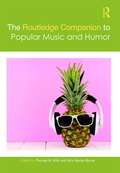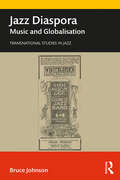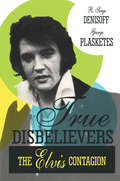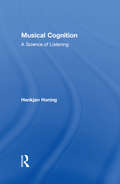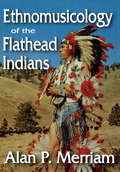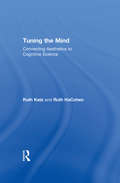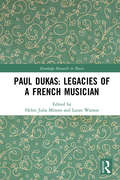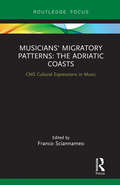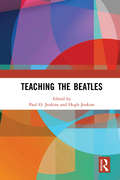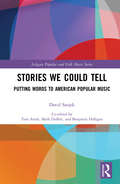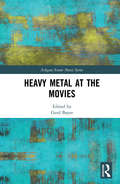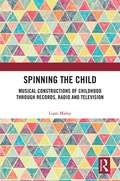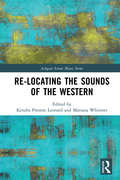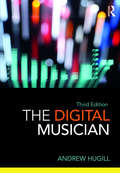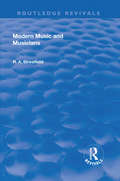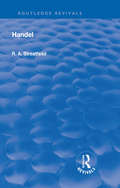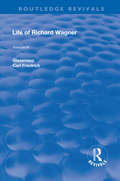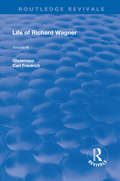I Love You, Baby Shark: Doo Doo Doo Doo Doo Doo (Baby Shark)
by John John BajetSing and dance along with Baby Shark in this story full of kisses, snuggles, and hugs -- the follow-up to the bestselling picture book!How does Baby Shark say "I love you"? No matter where you swim, near or far,My heart will be with you, wherever you are.In the light of day, to the night so dark,I will always love you, Baby Shark!Sing, dance, and read along to this brand-new love-filled song, featuring Baby Shark, Mama Shark, Daddy Shark, and more underwater friends. Perfect for bedtime, Valentine's Day, or any love-filled occasion, Kids and caregivers alike will delight in this silly illustrated story, full of funny, eye-popping illustrations and a catchy tune you won't be able to stop singing. Also features helpful picture guides so readers can dance along, act out the hand and foot movements, and develop their fine motor skills. Snuggle up with your little one and as you laugh, sing, and dance along to this charming and catchy read-aloud!
We Got the Music: A Peek Inside Julie's Notebook (Julie and the Phantoms)
by G. M. KingCheck out Julie and Luke's lyrics, Flynn's gig schedule for the band, and original Sunset Curve memorabilia in this in-world guide to the hit Netflix show Julie and the Phantoms!Julie Molina is always writing in her notebook -- from lyric ideas to memories of her mom, and even plans for her band, Julie and the Phantoms (including words of wisdom like "Make sure no one realizes the guys are ghosts, not holograms").This fun, in-world guide includes notes between Julie and her best friend, Flynn; messy scribbles from Luke, Reggie, and Alex with ideas for new songs (hey, it's hard to hold a pencil when you're dead!); and suspicious theories from Julie's little brother, Carlos, about exactly what's going on out in the garage... Plus, there are full-color photos on every page!Explore all this and more in this exclusive peek at Julie and the Phantoms, the hit new show from High School Musical and Descendants director Kenny Ortega!
Whatever Happens (Julie and the Phantoms, Novel #1)
by Candace BufordJulie and the Phantoms' adventures continue in this original novel based on the hit Netflix show from Descendants director Kenny Ortega!Julie Molina and her band, Julie and the Phantoms, play their dream gig at the Orpheum. It was supposed to be Luke, Reggie, and Alex's unfinished business as ghosts, so they could cross over. But they didn't. And now, suddenly, Julie can feel them.Whatever happens next, Julie and the guys know they've just had one of the best days of their (after)lives. And it gets Luke and Julie thinking about their last perfect days...For Luke, it was the day he died -- the day Sunset Curve was supposed to play the Orpheum. For Julie, it was the day before she found out her mom was sick -- the last normal day before her life changed forever.This exclusive Julie and the Phantoms story is told in flashbacks and alternating points of view!
The Edge of Great (Julie and the Phantoms, Season One Novelization)
by Micol OstowAfter the passing of her mom, Julie has lost her passion for music and is on the verge of being kicked out of her performing arts high school. That is, until she makes the ultimate comeback with her new band, Julie and the Phantoms. There's only one catch: all of her bandmates are ghosts. Back in the 1990s, Luke, Reggie, and Alex were on the cusp of rock stardom with their band, Sunset Curve, before an unfortunate encounter with Los Angeles street food brought their rock band dreamsand livesto an end. Now, with Julie as their lead singer, the guys have a second chance to make it big and to help Julie discover the real power of music. This novel based on season one of the hit Netflix series Julie and the Phantoms is told in alternating points of view and includes exclusive story content not seen on the show!
Twinkle, Twinkle, You’re a Star! / ¡Estrellita, brillarás! (Baby Shark)
by John John BajetDive under the sea to sing and dance with Baby Shark and all his friends, in this underwater twist on a preschool-favorite song all about building confidence!¡Canta y baila con Bebé Tiburón en esta versión submarina de "Estrellita, dónde estás"! Bebé Tiburón y sus amigos le recuerdan a Estrella de Mar todos los motivos por los que es una ESTRELLA, ¡y la animan a compartir su luz, centellear con fuerza y brillar! Con un reparto adorable de personajes submarinos y una variación pegajosa de la popular canción, ¡tu pequeño adorará sumergirse en el mar con Bebé Tiburón!Sing and dance with Baby Shark, in this underwater rendition of "Twinkle, Twinkle Little Star"! With messages of encouragement and confidence-building, Baby Shark and his friends remind Starfish all the ways she is a STAR, encouraging her to share her glow, twinkle boldly, and shine bright! Featuring an adorable cast of underwater characters, a catchy twist on a pre-school favorite song, and a page of stickers, your little one will love diving under the sea with Baby Shark!
Cantaba la rana / The Frog Was Singing
by Rita Rosa Ruesga ScholasticScholastic and Latin Grammy nominee Rita Rosa Ruesga have joined together to bring a wonderful bilingual songbook.¡Las canciones infantiles más populares de Latinoamérica! Con la letra de las canciones en español e inglés, las partituras correspondientes y hermosas ilustraciones, esta colección es una introducción ideal a la rica tradición musical de los países hispanohablantes. A los chicos les encantará.
We Shall Overcome
by Bryan CollierA celebration of the gospel anthem and Civil Rights protest song "We Shall Overcome," masterfully brought to life by Caldecott Honor recipient and a nine-time Coretta Scott King Award winner Bryan Collier."We Shall Overcome" is one of the most recognizable anthems of the Civil Rights movement, widely performed at protests and rallies to promote nonviolent civil rights activism. Now, these inspirational, empowering, legendary lyrics are brought to life with the stirring, evocative, and breathtaking illustrations from multi-award-winning talent Bryan Collier. Powerfully imagined for the present moment, Collier's illustrations meld the most emblematic moments of the twentieth-century Civil Rights movement with the present day, depicting the movements, protests, and demonstrations -- big and small -- as the fight for justice continues. With illustrations full of depth, tenderness, and expression, and offering historical context while remaining powerfully relevant to the present-day, this impactful picture book is a must-have for every home, classroom, and bookshelf.
Karma's World: The Great Shine-a-Thon Showcase
by Halcyon PersonThis brand-new chapter book series follows aspiring rapper and hip-hop artist Karma from the Netflix animated series Karma's World!Meet Karma Grant! Karma and her friends are totally stoked for the MC Grillz concert in their neighborhood, Hansberry Heights! But when the famous rapper's bus breaks down and the show is canceled, it's up to Karma to make the best of some bad luck. Will Karma be able to put on her own concert, the Shine-a-Thon, with her friends or will the pressure prove to be way too much? Filled with heart, humor and Karma's own rhymes, this original chapter book is sure to delight any fans of the show!
Music, Health and Wellbeing
by Naomi Sunderland Natalie Lewandowski Dan Bendrups Brydie-Leigh BartleetThis book explores the power music has to address health inequalities and the social determinants of health and wellbeing. It examines music participation as a determinant of wellbeing and as a transformative tool to impact on wider social, cultural and environmental conditions. Uniquely, in this volume health and wellbeing outcomes are conceptualised on a continuum, with potential effects identified in relation to individual participants, their communities but also society at large. While arts therapy approaches have a clear place in the text, the emphasis is on music making outside of clinical contexts and the broader roles musicians, music facilitators and educators can play in enhancing wellbeing in a range of settings beyond the therapy room. This innovative edited collection will be of great interest to scholars and practitioners of music, social services, medical humanities, education and the broader health field in the social and medical sciences.
Learning Music Theory with Logic, Max, and Finale
by Geoffrey KiddeLearning Music Theory with Logic, Max, and Finale is a groundbreaking resource that bridges the gap between music theory teaching and the world of music software programs. Focusing on three key programs—the Digital Audio Workstation (DAW) Logic, the Audio Programming Language (APL) Max, and the music-printing program Finale—this book shows how they can be used together to learn music theory. It provides an introduction to core music theory concepts and shows how to develop programming skills alongside music theory skills. Software tools form an essential part of the modern musical environment; laptop musicians today can harness incredibly powerful tools to create, record, and manipulate sounds. Yet these programs on their own don’t provide musicians with an understanding of music notation and structures, while traditional music theory teaching doesn’t fully engage with technological capabilities. With clear and practical applications, this book demonstrates how to use DAWs, APLs, and music-printing programs to create interactive resources for learning the mechanics behind how music works. Offering an innovative approach to the learning and teaching of music theory in the context of diverse musical genres, this volume provides game-changing ideas for educators, practicing musicians, and students of music. The author's website at http://www.geoffreykidde.com includes downloadable apps that support this book.
Kendrick Lamar and the Making of Black Meaning (Routledge Studies in Hip Hop and Religion)
by Christopher M. Driscoll Monica R. Miller Anthony B. PinnKendrick Lamar has established himself at the forefront of contemporary hip-hop culture. Artistically adventurous and socially conscious, he has been unapologetic in using his art form, rap music, to address issues affecting black lives while also exploring subjects fundamental to the human experience, such as religious belief. This book is the first to provide an interdisciplinary academic analysis of the impact of Lamar’s corpus. In doing so, it highlights how Lamar’s music reflects current tensions that are keenly felt when dealing with the subjects of race, religion and politics. Starting with Section 80 and ending with DAMN., this book deals with each of Lamar’s four major projects in turn. A panel of academics, journalists and hip-hop practitioners show how religion, in particular black spiritualties, take a front-and-center role in his work. They also observe that his astute and biting thoughts on race and culture may come from an African American perspective, but many find something familiar in Lamar’s lyrical testimony across great chasms of social and geographical difference. This sophisticated exploration of one of popular culture’s emerging icons reveals a complex and multi faceted engagement with religion, faith, race, art and culture. As such, it will be vital reading for anyone working in religious, African American and hip-hop studies, as well as scholars of music, media and popular culture.
Teaching Music in American Society: A Social and Cultural Understanding of Teaching Music
by Steven N. KellyTeaching Music in American Society, Third Edition, provides a comprehensive overview of social and cultural themes directly related to music education, teacher training, and successful teacher characteristics. Music teachers need to be not only knowledgeable in conducting and performing but also socially and culturally aware of students, issues, and events that affect their classrooms. This book is designed for educators seeking K-12 music teacher certification to teach in American schools. At the conclusion of each chapter is a summary of the chapter and a list of key items and people discussed, plus a series of related questions for students to consider. Current topics in the third edition include: • an emphasis on social justice, sensitivity to transgender students, and bullying, • the influences of social media, • a focus on urban music education, and • a new chapter on diverse learning. Further, recent policy issues are addressed in this new edition: • the evolution of the No Child Left Behind Act into the Every Student Succeeds Act, • the increasing emphasis on charter schools, the privatization of public school, • changes in how schools are assessed, and • changes occurring within the teaching profession—and how all of these affect developments in music education. A major structural change is the chapter on equality of education has been split into two chapters, providing a stronger focus on both educational equality and diverse inclusive learning.
Status Quo: Mighty Innovators Of 70s Rock (Ashgate Popular and Folk Music Series)
by Andrew L. CopeStatus Quo were one of the most successful, influential and innovative bands of the 1970s. During the first half of the decade, they wrote, recorded and performed a stream of inventive and highly complex rock compositions, developed 12 bar forms and techniques in new and fascinating ways, and affected important musical and cultural trends. But, despite global success on stage and in the charts, they were maligned by the UK music press, who often referred to them as lamebrained three-chord wonders, and shunned by the superstar Disk Jockeys of the era, who refused to promote their music. As a result, Status Quo remain one of the most misunderstood and underrated bands in the history of popular music. Cope redresses that misconception through a detailed study of the band’s music and live performances, related musical and cultural subtopics and interviews with key band members. The band is reinstated as a serious, artistic and creative phenomenon of the 1970s scene and shown to be vital contributors to the evolution of rock.
Critical Perspectives on Michael Finnissy: Bright Futures, Dark Pasts (Ashgate Studies in Theory and Analysis of Music After 1900)
by Ian Pace Nigel McBrideThe composer and pianist Michael Finnissy (b. 1946) is an unmistakeable presence in the British and international new music scene, both for his immeasurable generosity as prolific composer for many different types of musicians, major advocate for the works of others, and performer and conductor who has also been a driving force behind ensembles; he was also President of the International Society for Contemporary Music from 1990 to 1996. His vast and enormously varied output confounds those who seek easy categorisations: once associated strongly with the ‘new complexity’, Finnissy is equally known as composer regularly engaged with many different folk musics, for working with amateur and community musicians, for a long-term engagement with sacred music, or as an advocate of Anglo-American ‘experimental’ music. Twenty years ago, a large-scale volume entitled Uncommon Ground: The Music of Michael Finnissy gave the first major overview of the output of any ‘complex’ composer. This new volume brings a greater plurality of perspectives and critical sensibility to bear upon an output which is almost twice as large as it was when the earlier book was published. A range of leading contributors – musicologists, composers, performers and others – each grapple with particular questions relating to Finnissy’s music, often in ways which raise questions relating more widely to new music, and provide theoretical foundations for further of study both of Finnissy and other composers.
The Music of Dada: A lesson in intermediality for our times
by Peter Dayan100 years after the Dada soirées rocked the art world, the author investigates the role that music played in the movement. Dada is generally thought of as noisy and unmusical, but The Music of Dada shows that music was at the core of Dada theory and practice. Music (by Schoenberg, Satie and many others) performed on the piano played a central role in the soirées, from the beginnings in Zurich, in 1916, to the end in Paris and Holland, seven years later. The Music of Dada provides a historical analysis of music at Dada events, and asks why accounts of Dada have so consistently ignored music’s vital presence. The answer to that question turns out to explain how music has related to the other arts ever since the days of Dada. The music of Dada is the key to understanding intermediality in our time.
The Cyclic Mass: Anglo-Continental Exchange in the Fifteenth Century (Royal Musical Association Monographs)
by James CookEngland in the fifteenth century was the cradle of much that would have a profound impact on European music for the next several hundred years. Perhaps the greatest such development was the cyclic cantus firmus Mass, and scholarly attention has therefore often been drawn to identifying potentially English examples within the many anonymous Mass cycles that survive in continental sources. Nonetheless, to understand English music in this period is to understand it within a changing nexus of two-way cultural exchange with the continent, and the genre of the Mass cycle is very much at the forefront of this. Indeed, the question of ‘what is English’ cannot truly be answered without also answering the question of ‘what is continental’. This book seeks, initially, to answer both of these questions. Perhaps more importantly, it argues that a number of the works that have induced the most scholarly debate are best seen through the lens of intensive and long-term cultural exchange and that the great binary divide of provenance can, in many cases, productively be broken down. A great many of these works, though often written on the continent, can, it seems, only be understood in relation to English practice – a practice which has had, and will continue to have, major importance in the ongoing history of European Art Music.
Richard D’Oyly Carte (Music in Nineteenth-Century Britain)
by Paul SeeleyThe first biography of Richard D’Oyly Carte, this is a critical survey of the career of the impresario whose ambitions went beyond the famous partnership of Gilbert and Sullivan. Errors and misconceptions in current literature are challenged and corrected to give a truer portrayal of one of the most influential music theatre promoters in the nineteenth century.
Advancing Music Education in Northern Europe
by David G. Hebert Torunn Bakken HaugeAdvancing Music Education in Northern Europe tells the story of a unique organization that has contributed in profound ways to the professional development of music teachers in the Nordic and Baltic nations. At the same time, the book offers reflections on how music education and approaches to the training of music teachers have changed across recent decades, a period of significant innovations. In a time where international partnerships appear to be threatened by a recent resurgence in protectionism and nationalism, this book also more generally demonstrates the value of formalized international cooperation in the sphere of higher education. The setting for the discussion, Northern Europe, is a region arguably of great importance to music education for a number of reasons, seen, for instance, in Norway’s ranking as the “happiest nation on earth”, the well-known success of Finland’s schools in international-comparative measures of student achievement, how Sweden has grappled with its recent experience as “Europe’s top recipient of asylum seekers per capita”, and Estonia’s national identity as a country born from a “Singing Revolution”, to name but a few examples. The contributors chronicle how the Nordic Network for Music Education (NNME) was founded and developed, document its impact, and demonstrate how the eight nations involved in this network – Norway, Iceland, Denmark, Sweden, Finland, Estonia, Latvia, and Lithuania – are making unique contributions of global significance to the field of music education.
Metal, Rap, and Electro in Post-Revolutionary Tunisia: A Fragile Underground (Routledge Studies in Popular Music)
by Stefano BaroneMetal, Rap, and Electro in Tunisia is a trip into the music scenes of Tunisia after the Arab Springs. Based on extensive field research, the book explores the social life of heavy metal, rap, and electronic music in a North African country whose mass revolution of 2010/2011 led the way to a troubled and yet unique democracy. What is it like to be part of a music scene in a place affected by poverty and inequality? How do the many conflicted souls of Tunisian Islam shape local metal, rap, and electro? What are the social and cultural stakes for music in a nation constantly represented as a bridge between Europe and the Middle East? How do music scenes articulate the complex political scenario that followed the Tunisian revolution of 2011? Barone answers these questions by offering new theoretical reflections on youth cultures and popular music in a global perspective, and thus pushing the debate on "post-subcultures" and scenes forward. At the same time, the book offers a dense sociological analysis of youth and music in reality - the Tunisian one - whose society, culture, religion, and politics are at stake in a historical transformation.
The Sound State of Uzbekistan: Popular Music and Politics in the Karimov Era (SOAS Studies in Music Series)
by Kerstin KlenkeThe Sound State of Uzbekistan: Popular Music and Politics in the Karimov Era is a pioneering study of the intersection between popular music and state politics in Central Asia. Based on 20 months of fieldwork and archival research in Tashkent, this book explores a remarkable era in Uzbekistan’s politics (2001–2016), when the Uzbek government promoted a rather unlikely candidate to the prominent position of state sound: estrada, a genre of popular music and a musical relic of socialism. The political importance it attached to estrada was matched by the establishment of an elaborate bureaucratic apparatus for state oversight. The Sound State of Uzbekistan shows the continuing legacy of Soviet concepts to frame the nexus between music, artists and the state, and explains the extraordinary potency ascribed to estrada. At the same time, it challenges classical readings of transition and also questions common binary models for researching culture in totalitarian or authoritarian states. Proposing to approach lives in music under authoritarianism as a form of normality instead, the author promotes a post-Cold War paradigm in music studies.
Music History and Cosmopolitanism
by Anastasia Belina Kaarina Kilpiö Derek B. ScottThis collection of essays is the first book-length study of music history and cosmopolitanism, and is informed by arguments that culture and identity do not have to be viewed as primarily located in the context of nationalist narratives. Rather than trying to distinguish between a true cosmopolitanism and a false cosmopolitanism, the book presents studies that deepen understanding of the heritage of this concept – the various ways in which the term has been used to describe a wide range of activity and social outlooks. It ranges over a two hundred-year period, and more than a dozen countries, revealing how musicians and audiences have responded to a common humanity by embracing culture beyond regional or national boundaries. Among the various topics investigated are: musical cosmopolitanism among composers in Latin America, the Ottoman Empire, and Austro-Hungarian Empire; cosmopolitan popular music historiography; cosmopolitan musical entrepreneurs; and musical cosmopolitanism in the metropolises of New York and Shanghai.
Popular Song in the First World War: An International Perspective (Ashgate Popular and Folk Music Series)
by John MullenWhat did popular song mean to people across the world during the First World War? For the first time, song repertoires and musical industries from countries on both sides in the Great War as well as from neutral countries are analysed in one exciting volume. Experts from around the world, and with very different approaches, bring to life the entertainment of a century ago, to show the role it played in the lives of our ancestors. The reader will meet the penniless lyricist, the theatre chain owner, the cross-dressing singer, fado composer, stage Scotsman or rhyming soldier, whether they come from Serbia, Britain, the USA, Germany, France, Portugal or elsewhere, in this fascinating exploration of showbiz before the generalization of the gramophone. Singing was a vector for patriotic support for the war, and sometimes for anti-war activism, but it was much more than that, and expressed and constructed debates, anxieties, social identities and changes in gender roles. This work, accompanied by many links to online recordings, will allow the reader to glimpse the complex role of popular song in people’s lives in a period of total war.
Kaikhosru Sorabji's Letters to Philip Heseltine (Peter Warlock)
by Barry Smith Brian InglisTwo extraordinary personalities, and one remarkable friendship, are reflected in the unique corpus of letters from Anglo-Parsi composer-critic Kaikhosru Sorabji (1892-1988) to Philip Heseltine (Peter Warlock) (1894-1930): a fascinating primary source for the period 1913-1922 available in a complete scholarly edition for the first time. The volume also provides a new contextual, critical and interpretative framework, incorporating a myriad of perspectives: identities, social geographies, style construction, and mutual interests and influences. Pertinent period documents, including evidence of Heseltine’s reactions, enhance the sense of narrative and expand on aesthetic discussions. Through the letters’ entertaining and perceptive lens, Sorabji’s early life and compositions are vividly illuminated and Heseltine’s own intriguing life and work recontextualised. What emerges takes us beyond tropes of otherness and eccentricity to reveal a persona and a narrative with great relevance to modern-day debates on canonicity and identity, especially the nexus of ethnicity, queer identities and Western art music. Scholars, performers and admirers of early twentieth-century music in Britain, and beyond, will find this a valuable addition to the literature. The book will appeal to those studying or interested in early musical modernism and its reception; cultural life in London around and after the First World War; music, nationality and race; Commonwealth studies; and music and sexuality.
Bending the Rules of Music Theory: Lessons from Great Composers
by Timothy CutlerFor students learning the principles of music theory, it can often seem as though the tradition of tonal harmony is governed by immutable rules that define which chords, tones, and intervals can be used where. Yet even within the classical canon, there are innumerable examples of composers diverging from these foundational "rules." Drawing on examples from composers including J.S. Bach, Mozart, Beethoven, Schubert, Mendelssohn, Chopin, Brahms, and more, Bending the Rules of Music Theory seeks to take readers beyond the basics of music theory and help them to understand the inherent flexibility in the system of tonal music. Chapters explore the use of different rule-breaking elements in practice and why they work, introducing students to a more nuanced understanding of music theory.
Made in Taiwan: Studies in Popular Music (Routledge Global Popular Music Series)
by Eva Tsai Tung-Hung Ho Miaoju JianMade in Taiwan: Studies in Popular Music serves as a comprehensive introduction to the history, sociology, and musicology of contemporary Taiwanese popular music. Each essay, written by a leading scholar of Taiwanese music, covers the major figures, styles, and social contexts of pop music in Taiwan and provides adequate context so readers understand why the figure or genre under discussion is of lasting significance. The book first presents a general description of the history and background of popular music in Taiwan, followed by essays organized into thematic sections: Trajectories, Identities, Issues, and Interactions.
Made in Poland: Studies in Popular Music (Routledge Global Popular Music Series)
by Patryk GaluszkaMade in Poland: Studies in Popular Music serves as a comprehensive introduction to the history, sociology, and musicology of contemporary Polish popular music. Each essay, written by a leading scholar of Polish music, covers the major figures, styles, and social contexts of pop music in Poland and provides adequate context so readers understand why the figure or genre under discussion is of lasting significance. The book first presents a general description of the history and background of popular music in Poland, followed by essays organized into thematic sections: Popular Music in the People’s Republic of Poland; Documenting Change and Continuity in Music Scenes and Institutions; and Music, Identity, and Critique.
A History of the Symphony: The Grand Genre
by Jeffrey LangfordA History of the Symphony: The Grand Genre identifies the underlying cultural factors that have shaped the symphony over the past three hundred years, presenting a unified view of the entire history of the genre. The text goes beyond discussions of individual composers and the stylistic evolution of the genre to address what constitutes a symphony within each historical period, describing how such works fit into the lives of composers and audiences of the time, recognizing that they do not exist in a vacuum but rather as the products of numerous external forces spurring their creation. In three parts, the text proceeds chronologically, drawing connections between musical examples across regions and eras: The Classical Symphony The Romantic Symphony The Symphony in the Modern Era Within this broad chronology—from the earliest Italian symphonies of the 18th century to the most experimental works of the 20th century—discussion of the development of the genre often breaks down along national lines that outline divergent but parallel paths of stylistic growth. In consideration of what is and is not a symphony, musical developments in other genres are presented as they relate to the symphony, genres such as the serenade, the tone poem, and the concert overture. Suitable for a one-semester course as well as a full-year syllabus, and with illustrative musical examples throughout, A History of the Symphony places composers and works in sociological and musical contexts while confronting the fundamental question: What is a symphony?
Ibbs and Tillett: The Rise and Fall of a Musical Empire
by Christopher FifieldFor the greater part of the twentieth century, Ibbs and Tillett's concert agency was to the British music industry what Marks and Spencer is to the world of the department store. The roll-call of famous musicians on its books was unmatched, and included such international stars as Clara Butt, Fritz Kreisler, Pablo Casals, Sergei Rachmaninov, Andr Segovia, Kathleen Ferrier, Myra Hess, Jacqueline du Pr Clifford Curzon and Vladimir Ashkenazy, to name but a handful. From 1906, the success of the company was due to the dedication of its founders, Robert Leigh Ibbs and John Tillett. After their deaths, the agency was run by the latter's wife, Emmie, who, dubbed the 'Duchess of Wigmore Street', became one of the most formidable yet respected women in British music. The history of this unique institution and its owners is told here for the first time, often through the fascinating letters that were exchanged between the artists themselves and the agency. It begins in the latter years of the 19th century with the concert and theatrical manager Narciso Vert, for whom both Ibbs and Tillett worked until his death in 1905. The story then becomes a history of musical life in twentieth-century Britain, illuminating aspects of the day-to-day management of concerts and festivals, the lives and livelihoods of professional musicians, as well as those who strove to join their ranks through audition or recommendation. The changing profile, and particularly the onset and development of personal management of artists represented by Ibbs and Tillett and their reception in the press, can be viewed as a barometer of musical taste. The demise of the agency in 1990 was indicative of just how much the world of British music had changed by the end of the century, but despite its loss to the profession, the legacy and influence of Ibbs and Tillett has remained a benchmark in today's highly competitive world of artist management and concert promotion, many of whose principal operators began
Alun Hoddinott: A Source Book (Bio-bibliographies In Music Ser. #No. 44)
by R. Craggs StewartAlun Hoddinott is the most important living Welsh composer and one of the most distinguished and prolific composers of his generation internationally. His works have been performed in major centres as far afield as Tokyo and Berlin, Melbourne and Leipzig, New York and Venice as well as the major festivals in Wales and England. He is one of the very few composers to have been commissioned to compose a concerto for Mstislav Rostropovitch.Born in Bargoed, Glamorganshire, in August 1929, Alun Hoddinott started to play the violin and compose at an early age. Some of his works were performed and broadcast whilst he was a student at University College, Cardiff and he later studied with the Australian composer and pianist Arthur Benjamin. His first major success was his Clarinet Concerto No.1, given by Gervaise de Peyer and the Halle Orchestra under John Barbirolli at the 1954 Cheltenham Music Festival.This Source Book lists all Hoddinott's compositions from 1946 to 2005, almost 60 years of phenomenal output, and shows he has achieved a mastery of composition which embraces almost every musical medium. With information given on first performances, manuscript locations and recordings, in addition to details of composition dates, authors/librettists, durations, commissions and dedications amongst much else, this book is a key reference for all those interested in Alun Hoddinott and his music.
Alan Bush: A Source Book
by Stewart R. CraggsBorn in 1900, Alan Bush, the English composer, conductor and pianist, studied with Corder and Matthay, and privately with John Ireland. He was appointed professor of harmony and composition at the Royal Academy of Music in 1925, a post he held until 1978. In 1929-31, he continued to study at Berlin University and had piano lessons with Moiseiwitsch and Schnabel. The present Source Book documents his works (many of which reflect his Communist sympathies) and the many arrangements of music by other composers. A wealth of detail is provided, including printed scores, CD recordings, bibliographical material and manuscript scores and their locations, the majority of which have been deposited recently in the British Library by the Bush family. A chronology of the composer's life draws on many sources including letters and scrapbooks.
The Music of Joonas Kokkonen
by Edward JurkowskiJoonas Kokkonen (1921-1996) has been one of the most performed Finnish composers during the past 25 years both within Finland and abroad.The author's study of Joonas Kokkonen is the first full-scale account in English. Starting with a brief survey of Finnish music during the 20th century, the book then devotes a separate chapter to each of the major genres in which Kokkonen composed: symphonic, orchestral, vocal, chamber and keyboard. Illustrated with over a hundred music examples, The Music of Joonas Kokkonen seeks to overturn his reputation in some quarters as a conservative, even old fashioned, composer, and argues that Kokkonen created an interesting and refreshing approach to dodecaphonic composition and pitch organization. With a full chronological listing of works and bibliography, this book is the most important reference source to date on Kokkonen and his music." "Book Description: One of the most performed Finnish composers during the last 25 years, Joonas Kokkonen (1921-1996) was also instrumental in the development of the nation's system of music education. In this study,the author (music, U. of Lethbridge, Canada) examines Kokkonen's compositions in each of five major genres: symphonic, orchestral, vocal, chamber, and key
Professional Music-making in London: Ethnography and Experience (Soas Musicology Ser.)
by Stephen CottrellProfessional Music-Making in London is an engaging yet innovative study which examines the lives and work of Western art musicians from an ethnographic perspective. Drawing in part on his own professional experience, Stephen Cottrell considers to what extent musicians in Western society conform to Alan Merriam's paradigmatic assessment of them as having low status yet high respect, as well as being given an unusual degree of licence to deviate from convention. The book draws on a wide variety of approaches from scholars elsewhere: from ethnomusicologists such as Bruno Nettl and Henry Kingsbury, performance theorists such as Richard Schechner and Victor Turner, as well as psychologists such as Sigmund Freud and Melanie Klein. This rich intellectual heritage provides the framework for discussion of a variety of themes, including how musicians conceive their self identity and how this is negotiated in the professional musical world; how the deputy system facilitates musical exchange and engenders gift relationships; how humour lubricates social and musical relationships and mitigates the stresses of musicians' lives; and how the events in which musicians participate can be viewed as quasi-rituals, and thus related to analogous events in non-Western cultures. The focus of this study is on professional music-making in London, one of the world's busiest centres of musical performance - yet the issues raised and explored are deeply relevant to other major centres of Western art music, such as New York, Berlin or Sydney. Ethnomusicologists, anthropologists, musicologists, performers, teachers and concert-goers will find this book a stimulating insight into, and investigation of, Western art musicians and their place in today's world.
Instrumental Teaching in Nineteenth-Century Britain (Music In Nineteenth-century Britain Ser.)
by David GolbyIt is a truth widely acknowledged that, while part of a uniquely diverse and vibrant musical environment, the achievements of home-grown British instrumentalists in the nineteenth century gave little cause for national pride. Drawing together information from a wide variety of primary and secondary sources, in particular treatises and tutors, David Golby demonstrates that while Britain produced many fewer instrumental virtuosi than its foreign neighbours, there developed a more serious and widespread interest in the cultivation of music throughout the nineteenth century. Taking a predominantly historical approach, the book moves from a discussion of general developments and issues to a detailed examination of violin pedagogy, method and content which is used as a guide to society's influence on cultural trends and informs the discussion of other instruments and institutional training that follows. In the first study of its kind Dr Golby examines in depth the inextricable links between trends in society, education and levels of achievement. He also extends his study beyond professional and 'art' music to incorporate the hugely significant amateur and 'popular' spheres. To provide a contextual framework for the study, the book includes a chronology of developments in 19th-century British music education, and a particularly useful feature for future researchers in this field is a representative chronology of principal British instrumental treatises 1780-1900 that features over 700 items.
Decline, Renewal and the City in Popular Music Culture: Beyond the Beatles (Ashgate Popular And Folk Music Ser.)
by Sara CohenHow is popular music culture connected with the life, image, and identity of a city? How, for example, did the Beatles emerge in Liverpool, how did they come to be categorized as part of Liverpool culture and identity and used to develop and promote the city, and how have connections between the Beatles and Liverpool been forged and contested? This book explores the relationship between popular music and the city using Liverpool as a case study. Firstly, it examines the impact of social and economic change within that city on its popular music culture, focusing on de-industrialization and economic restructuring during the 1980s and 1990s. Secondly, and in turn, it considers the specificity of popular music culture and the many diverse ways in which it influences city life and informs the way that the city is thought about, valued and experienced. Cohen highlights popular music's unique role and significance in the making of cities, and illustrates how de-industrialization encouraged efforts to connect popular music to the city, to categorize, claim and promote it as local culture, and harness and mobilize it as a local resource. In doing so, she adopts an approach that recognizes music as a social and symbolic practice encompassing a diversity of roles and characteristics: music as a culture or way of life distinguished by social and ideological conventions; music as sound; speech and discourse about music; and music as a commodity and industry.
Dance and Dancers in the Victorian and Edwardian Music Hall Ballet (Music In Nineteeth-century Britain Ser.)
by Alexandra CarterThe Victorian and Edwardian music hall ballet has been a neglected facet of dance historiography, falling prey principally to the misguided assumption that any ballet not performed at the Opera House or 'legitimate' theatre necessarily meant it was of low cultural and artistic merit. Here Alexandra Carter identifies the traditional marginalization of the working class female participants in ballet historiography, and moves on to reinstate the 'lost' period of the music hall ballet and to apply a critical account of that period. Carter examines the working conditions of the dancers, the identities and professional lives of the ballet girls and the ways in which the ballet of the music hall embodied the sexual psyche of the period, particularly in its representations of the ballet girl and the ballerina. By drawing on newspapers, journals, theatre programmes, contemporary fiction, poetry and autobiography, Carter firmly locates the period in its social, economic and artistic context. The book culminates in the argument that there are direct links between the music hall ballet and what has been termed the 'birth' of British ballet in the 1930s; a link so long ignored by dance historians. This work will appeal not only to those interested in nineteenth century studies, but also to those working in the fields of dance studies, gender studies, cultural studies and the performing arts.
Pioneer Violin Virtuose in the Early Twentieth Century: Maud Powell, Marie Hall, and Alma Moodie: A Gendered Re-Evaluation
by Tatjana GoldbergTatjana Goldberg reveals the extent to which gender and socially constructed identity influenced female violinists’ ‘separate but unequal’ status in a great male-dominated virtuoso lineage by focussing on the few that stood out: the American Maud Powell (1867–1920), Australian-born Alma Moodie (1898–1943), and the British Marie Hall (1884–1956). Despite breaking down traditional gender-based patriarchal social and cultural norms, becoming celebrated soloists, and greatly contributing towards violin works and the early recording industry (Powell and Hall), they received little historical recognition. Goldberg provides a more complete picture of their artistic achievements and the impact they had on audiences.
Punk Rock Warlord: the Life and Work of Joe Strummer (Ashgate Popular and Folk Music Series)
by Barry J. Faulk Brady HarrisonPunk Rock Warlord explores the relevance of Joe Strummer within the continuing legacies of both punk rock and progressive politics. It is aimed at scholars and general readers interested in The Clash, punk culture, and the intersections between pop music and politics, on both sides of the Atlantic. Contributors to the collection represent a wide range of disciplines, including history, sociology, musicology, and literature; their work examines all phases of Strummer’s career, from his early days as ’Woody’ the busker to the whirlwind years as front man for The Clash, to the ’wilderness years’ and Strummer’s final days with the Mescaleros. Punk Rock Warlord offers an engaging survey of its subject, while at the same time challenging some of the historical narratives that have been constructed around Strummer the Punk Icon. The essays in Punk Rock Warlord address issues including John Graham Mellor’s self-fashioning as ’Joe Strummer, rock revolutionary’; critical and media constructions of punk; and the singer’s complicated and changing relationship to feminism and anti-racist politics. These diverse essays nevertheless cohere around the claim that Strummer’s look, style, and musical repertoire are so rooted in both English and American cultures that he cannot finally be extricated from either.
Alban Berg: A Research and Information Guide (Routledge Music Bibliographies #Vol. 38)
by Bryan R. SimmsAlban Berg: A Research and Information Guide, Third Edition is an annotated bibliography highlighting both the nature of primary sources related to the composer and the scope and significance of the secondary sources that deal with Berg, his compositions, and his influence as a composer. It is a reliable, complete, and useful resource and a starting point for anyone—performer, teacher, student, or scholar—wanting to learn about Berg’s life, works, and cultural milieu. The third edition has 162 additional citations since the publication of the second edition, many arising after the expiration of copyright of Berg’s musical and archival works 2005. Many important new, primary sources of information have appeared, most notably the letter exchanges with his wife, recently published in a three-volume critical edition (in German), as well as letter exchanges with Alma Mahler and Erich Kleiber, and later correspondences with Anton Webern. There has also been a notable increase in the availability of commercial video recordings of Berg's operas, Wozzeck and Lulu.
Artist Management for the Music Business
by Paul AllenAnyone managing an artist’s career needs to be well versed and have a savvy understanding of the moving parts of the music business. You’ll learn how and why those moving parts "move," as well as how to manage and navigate a music-based career. Artist Management for the Music Business gives you a comprehensive view of how to generate income through music and how to strategically plan for future growth. The book is full of valuable practical insights. It includes interviews and case studies with examples of real-world management issues and outcomes. Updates to this new edition include the importance of online streaming to music careers, how anyone can effectively network, tools for successful negotiation, ways to identify and manage income sources, and guidance on the ever-changing social media landscape of the music business. This book gives you access to resources about artist management and the music business at its companion website, http://www.artistmanagementonline.com. There is no login, and the resources are updated regularly.
Pop Art and Popular Music: Jukebox Modernism (Routledge Research in Art History)
by Melissa L. MednicovThis book offers an innovative and interdisciplinary approach to Pop art scholarship through a recuperation of popular music into art historical understandings of the movement. Jukebox modernism is a procedure by which Pop artists used popular music within their works to disrupt decorous modernism during the sixties. Artists, including Peter Blake, Pauline Boty, James Rosenquist, and Andy Warhol, respond to popular music for reasons such as its emotional connectivity, issues of fandom and identity, and the pleasures and problems of looking and listening to an artwork. When we both look at and listen to Pop art, essential aspects of Pop’s history that have been neglected—its sounds, its women, its queerness, and its black subjects—come into focus.
Pop Music Production: Manufactured Pop and BoyBands of the 1990s (ISSN)
by Phil HardingPop Music Production delves into academic depths around the culture, the business, the songwriting, and most importantly, the pop music production process. Phil Harding balances autobiographical discussion of events and relationships with academic analysis to offer poignant points on the value of pure popular music, particularly in relation to BoyBands and how creative pop production and songwriting teams function.Included here are practical resources, such as recording studio equipment lists, producer business deal examples and a 12-step mixing technique, where Harding expands upon previously released material to explain how ‘Stay Another Day’ by East 17 changed his approach to mixing forever. However, it is important to note that Harding almost downplays his involvement in his career. At no point is he center stage; he humbly discusses his position within the greater scheme of events. Pop Music Production offers cutting-edge analysis of a genre rarely afforded academic attention.This book is aimed at lecturers and students in the subject fields of Music Production, Audio Engineering, Music Technology, Popular Songwriting Studies and Popular Music Culture. It is suitable for all levels of study from FE students through to PhD researchers. Pop Music Production is also designed as a follow-up to Harding’s first book PWL from the Factory Floor (2010, Cherry Red Books), a memoir of his time working with 1980s pop production and songwriting powerhouse, Stock Aitken Waterman, at PWL Studios.
Film Music in the Sound Era: A Research and Information Guide, Volume 1: Histories, Theories, and Genres (Routledge Music Bibliographies)
by Jonathan Rhodes LeeFilm Music in the Sound Era: A Research and Information Guide offers a comprehensive bibliography of scholarship on music in sound film (1927–2017). Thematically organized sections cover historical studies, studies of musicians and filmmakers, genre studies, theory and aesthetics, and other key aspects of film music studies. Broad coverage of works from around the globe, paired with robust indexes and thorough cross-referencing, make this research guide an invaluable tool for all scholars and students investigating the intersection of music and film. This guide is published in two volumes: Volume 1: Histories, Theories, and Genres covers overviews, historical surveys, theory and criticism, studies of film genres, and case studies of individual films. Volume 2: People, Cultures, and Contexts covers individual people, social and cultural studies, studies of musical genre, pedagogy, and the Industry. A complete index is included in each volume.
Sweet Thunder: Music and Libretti in 1960s Italy
by Vivienne Suvini-Hand"Italian music of the 1960s is one of the most unjustly neglected areas in the arena of twentieth-century classical music. This volume pays tribute to the astounding complexity of the music and libretti of five vocal compositions by leading experimental composers of the decade: Luigi Dallapiccola, Bruno Maderna, Luciano Berio, Giacomo Manzoni, and Armando Gentilucci. It highlights how the 'difficult' and unconventional methods of composition employed by these artists - dodecaphony, total serialism, Webernian minimalist techniques, aleatory and electronic music - displayed a refusal to compete with the market-place values of Italy's new capitalist society. At the same time, the libretti's collage arrangement of a plethora of European and Oriental literary sources dating from the sixteenth century BC onwards, reflected the contemporary Neo-avant-garde rejection of conventional literary practice, and their preference for 'organised disorder', in Umberto Eco's phrase."
Made in Germany: Studies in Popular Music (Routledge Global Popular Music Series)
by Oliver SeibtMade in Germany: Studies in Popular Music serves as a comprehensive introduction to the history, sociology, and musicology of contemporary German popular music. Each essay, written by a leading scholar of German music, covers the major figures, styles, and social contexts of pop music in Germany and provides adequate context so readers understand why the figure or genre under discussion is of lasting significance. The book first presents a general description of the history and background of popular music in Germany, followed by essays organized into thematic sections: Historical Spotlights; Globally German; Also "Made in Germany"; Explicitly German; and Reluctantly German.
Anthology for Hearing Rhythm and Meter
by Matthew SantaThis full-score anthology for Hearing Rhythm and Meter: Analyzing Metrical Consonance and Dissonance in Common-Practice Period Music supports the textbook of the same name, the first book to present a comprehensive course text on advanced analysis of rhythm and meter. From the Baroque to the Romantic era, Hearing Rhythm and Meter emphasizes listening, enabling students to recognize meters and metrical dissonances by type both with and without the score. Found here are masterworks carefully chosen as the ideal context for the presentation of foundational concepts. PURCHASING OPTIONS Textbook (Print Paperback): 978-0-8153-8448-9 Textbook (Print Hardback): 978-0-8153-8447-2 Textbook (eBook): 978-1-351-20431-6 Anthology (Print Paperback): 978-0-8153-9176-0 Anthology (Print Hardback): 978-0-367-34924-0 Anthology (eBook): 978-1-351-20083-7
Music in Action Film: Sounds Like Action!
by James Buhler Mark DurrandMusic in Action Film is the first volume to address the central role of music and sound in action film—arguably the most dominant form of commercial cinema today. Bringing together 15 essays by established and emerging scholars, the book encompasses both Hollywood blockbusters and international films, from classic works such as The Seven Samurai to contemporary superhero franchises. The contributors consider action both as genre and as a mode of cinematic expression, in chapters on evolving musical conventions; politics, representation, and identity; musical affect and agency; the functional role of music and sound design in action film; and production technologies. Breaking new critical ground yet highly accessible, this book will be of interest to students and scholars of music and film studies.
Hearing Rhythm and Meter: Analyzing Metrical Consonance and Dissonance in Common-Practice Period Music
by Matthew SantaHearing Rhythm and Meter: Analyzing Metrical Consonance and Dissonance in Common-Practice Period Music is the first book to present a comprehensive course text on advanced analysis of rhythm and meter. This book brings together the insights of recent scholarship on rhythm and meter in a clear and engaging presentation, enabling students to understand topics including hypermeter and metrical dissonance. From the Baroque to the Romantic era, Hearing Rhythm and Meter emphasizes listening, enabling students to recognize meters and metrical dissonances by type both with and without the score. The textbook includes exercises for each chapter and is supported by a full-score anthology. PURCHASING OPTIONS Textbook (Print Paperback): 978-0-8153-8448-9 Textbook (Print Hardback): 978-0-8153-8447-2 Textbook (eBook): 978-1-351-20431-6 Anthology (Print Paperback): 978-0-8153-9176-0 Anthology (Print Hardback): 978-0-367-34924-0 Anthology (eBook): 978-1-351-20083-7
Robert Saxton: Caritas (Landmarks in Music Since 1950)
by Wyndham ThomasCaritas relates the 'true', yet largely undocumented story of Christine Carpenter, a 14th-century anchoress who moves towards insanity as her desire for a divine revelation continues to be unfulfilled after a period of three years locked in her cell. Although physically isolated, she is aware of the worldly life and love that she has abandoned. The very essence of the drama is the dogmatic refusal of her Bishop to release her from her vows. Set against the backcloth of the Peasants' Uprising (1381), the libretto/play juxtaposes sacred and secular worlds, the relative power and servitude of rulers and serfs, and the terrifying ordeal of Christine who is caught between the inflexibility of the established church and her personal religious expectations. Such a narrative was to offer rich opportunities for musical characterization and evocation of the historical context of the action, as well as substantial challenges in pacing and integrating the sequence of dramatic 'snap-shots' that culminate in a scene of total despair. The colourful juxtaposition of secular life and that of a recluse in Act One culminates in a Second Act finale of immense dramatic power in which Saxton's vocal and instrumental writing reaches new heights - a landmark both in his output and in late 20th century opera. Caritas - first performed in 1991 - occupies an important position in Robert Saxton's output and, as Thomas argues, in British opera during the closing decades of the 20th century. Thomas provides a detailed contextual setting in which to evaluate Caritas, as well as presenting an analytical commentary on the structure, musical language, instrumentation, staging and production of the opera. Thomas concludes with a reflection on the reception of Caritas as well as looking forward to Saxton's later and future works. A CD of the first performance is included.
From Pac-Man to Pop Music: Interactive Audio in Games and New Media (Ashgate Popular And Folk Music Ser.)
by Karen CollinsDigital interactive audio is the future of audio in media - most notably video games, but also web pages, theme parks, museums, art installations and theatrical events. Despite its importance to contemporary multi-media, this is the first book that provides a framework for understanding the history, issues and theories surrounding interactive audio. Karen Collins presents the work of academics, composers and sound programmers to introduce the topic from a variety of angles in order to provide a supplementary text for music and multimedia courses. The contributors cover practical and theoretical approaches, including historical perspectives, emerging theories, socio-cultural approaches to fandom, reception theory and case study analyses. The book offers a fresh perspective on media music, one that will complement film studies, but which will show the necessity of a unique approach when considering games music.
Landscapes of the Mind: The Music of John McCabe
by George OdamLiverpool-born composer and pianist, John McCabe, established himself as one of Britain's most recorded contemporary composers as well as a celebrated performer and recording artist. This book covers every aspect of his compositions and will help guide both general and specialist listeners and performers through the so-called landscapes of the mind that his music evokes. The title was suggested by McCabe himself and his composing and performing life took him on journeys all over the world through a variety of landscapes, many of which are to be found in essence in his music. The detailed discography will help readers to find recordings of many of the works described in the series of articles written by a collection of experienced critics, performers, broadcasters and reviewers, and the copious illustrations and full pages of musical score provide a variety of insights into McCabe's life and work.
Music, Space and Place: Popular Music and Cultural Identity (Ashgate Popular And Folk Music Ser.)
by Andy BennettMusic, Space and Place examines the urban and rural spaces in which music is experienced, produced and consumed. The editors of this collection have brought together new and exciting perspectives by international researchers and scholars working in the field of popular music studies. Underpinning all of the contributions is the recognition that musical processes take place within a particular space and place, where these processes are shaped both by specific musical practices and by the pressures and dynamics of political and economic circumstances. Important discourses are explored concerning national culture and identity, as well as how identity is constructed through the exchanges that occur between displaced peoples of the world's many diasporas. Music helps to articulate a shared sense of community among these dispersed people, carving out spaces of freedom which are integral to personal and group consciousness. A specific focal point is the rap and hip hop music that has contributed towards a particular sense of identity as indigenous resistance vernaculars for otherwise socially marginalized minorities in Cuba, France, Italy, New Zealand and South Africa. New research is also presented on the authorial presence in production within the domain of the commercially driven Anglo-American music industry. The issue of authorship and creativity is tackled alongside matters relating to the production of musical texts themselves, and demonstrates the gender politics in pop. Underlying Music, Space and Place, is the question of how the disciplines informing popular music studies - sociology, musicology, cultural studies, media studies and feminism - have developed within a changing intellectual climate. The book therefore covers a wide range of subject matter in relation to space and place, including community and identity, gender, race, 'vernaculars', power, performance and production.
Living Electronic Music
by Simon EmmersonDrawing on recent ideas that explore new environments and the changing situations of composition and performance, Simon Emmerson provides a significant contribution to the study of contemporary music, bridging history, aesthetics and the ideas behind evolving performance practices. Whether created in a studio or performed on stage, how does electronic music reflect what is live and living? What is it to perform 'live' in the age of the laptop? Many performer-composers draw upon a 'library' of materials, some created beforehand in a studio, some coded 'on the fly', others 'plundered' from the widest possible range of sources. But others refuse to abandon traditionally 'created and structured' electroacoustic work. Lying behind this maelstrom of activity is the perennial relationship to 'theory', that is, ideas, principles and practices that somehow lie behind composers' and performers' actions. Some composers claim they just 'respond' to sound and compose 'with their ears', while others use models and analogies of previously 'non-musical' processes. It is evident that in such new musical practices the human body has a new relationship to the sound. There is a historical dimension to this, for since the earliest electroacoustic experiments in 1948 the body has been celebrated or sublimated in a strange 'dance' of forces in which it has never quite gone away but rarely been overtly present. The relationship of the body performing to the spaces around has also undergone a revolution as the source of sound production has shifted to the loudspeaker. Emmerson considers these issues in the framework of our increasingly 'acousmatic' world in which we cannot see the source of the sounds we hear.
Gustav Mahler: New Insights into His Life, Times and Work
by Alfred Mathis-RosenzweigAlfred Mathis-Rosenzweig (1897-1948) was a Viennese musicologist and critic who studied at the universities of Budapest and Vienna. From 1933 he embarked on producing a large-scale study of Mahler but at the time of his death the manuscript was left unfinished. Although it was presumed lost until 1997, the unfinished typescript, written in German, had been deposited in the library of the Guildhall School of Music & Drama. In 2003, the School‘s Research Centre commissioned Jeremy Barham to prepare the first published edition of this important work, and his annotations and commentary add invaluable material to his translation of this historic document. Biographical material is used as a loose framework and platform for Mathis-Rosenzweig‘s profound examination of the environment within which Mahler‘s earlier music was embedded. This is an environment in which Wagner, Bruckner and Wolf feature prominently, and in which Mahler‘s music is viewed from the wider perspective of nineteenth-century German cultural domination and the subsequent rise of political extremism in the form of Hitlerite fascism.
The Music of the Other: New Challenges for Ethnomusicology in a Global Age
by Laurent AubertWe are surrounded by new musical encounters today as never before, and the experience of musics from elsewhere is progressively affecting all arenas of the human conscience. Yet why is it that Western listeners expect a certain cultural and ethnic 'authenticity' or 'otherness' from visiting artists in world music, while contemporary musicians in Western music are no longer bound by such restraints? Should we feel uncomfortable when sacred rites from Asia or Africa are remade for Westerners as musical entertainment? As these thorny questions suggest, the great flood of world musics and of their agents into our most immediate cultural environment is not a simple matter of expanding global musical exchange. Instead, complex processes are at work involving the growth of intercontinental tourism, the development of new technologies of communication and our perceptions both of ourselves and of the new musical others now around us. Elegantly tracing the dimensions of these new musical encounters, Laurent Aubert considers the impact of world musics on our values, our habits and our cultural practices. His discussions of key questions about our contemporary music culture widen conventional ethnomusicological perspectives to consider not only the nature of Western society as a 'global village' but also the impact of current Western demands on the future of world musics and their practitioners.
White Boys, White Noise: Masculinities And 1980s Indie Guitar Rock (Ashgate Popular and Folk Music Series)
by Matthew BannisterTo what extent do indie masculinities challenge the historical construction of rock music as patriarchal? This key question is addressed by Matthew Bannister, involving an in-depth examination of indie guitar rock in the 1980s as the culturally and historically specific production of white men. Through textual analysis of musical and critical discourses, Bannister provides the first book-length study of masculinity and ethnicity within the context of indie guitar music within US, UK and New Zealand 'scenes'. Bannister argues that past theorisations of (rock) masculinities have tended to set up varieties of working-class deviance and physical machismo as 'straw men', oversimplifying masculinities as 'men behaving badly'. Such approaches disavow the ways that masculine power is articulated in culture not only through representation but also intellectual and theoretical discourse. By re-situating indie in a historical/cultural context of art rock, he shows how masculine power can be rearticulated through high, avant-garde, bohemian culture and aesthetic theory: canonism, negation (Adorno), passivity, voyeurism and camp (Andy Warhol and the Velvet Underground), and primitivism and infantilism (Lester Bangs, Simon Reynolds). In a related vein, he also assesses the impact of Freud on cultural theory, arguing that reversing binary conceptions of gender by associating masculinities with an essentialised passive femininity perpetuates patriarchal dualism. Drawing on his own experience as an indie musician, Bannister surveys a range of indie artists, including The Smiths, The Jesus and Mary Chain, My Bloody Valentine and The Go-Betweens; from the US, R.E.M., The Replacements, Dinosaur Jr, Hüsker Dü, Nirvana and hardcore; and from NZ, Flying Nun acts, including The Chills, The Clean, the Verlaines, Chris Knox, Bailter Space, and The Bats, demonstrating broad continuities between these apparently disparate scenes, in terms of gender, aesthetic theory and approaches to popular musical history. The result is a book which raises some important questions about how gender is studied in popular culture and the degree to which alternative cultures can critique dominant representations of gender.
The Resisting Muse: Popular Music and Social Protest (Ashgate Popular and Folk Music Series)
by Ian PeddiePopular music has traditionally served as a rallying point for voices of opposition, across a huge variety of genres. This volume examines the various ways popular music has been deployed as anti-establishment and how such opposition both influences and responds to the music produced. Implicit in the notion of resistance is a broad adversarial hegemony against which opposition is measured. But it would be wrong to regard the music of popular protest as a kind of dialogue in league against 'the establishment'. Convenient though they are, such 'us and them' arguments bespeak a rather shop-worn stance redolent of youthful rebellion. It is much more fruitful to perceive the relationship as a complex dialectic where musical protest is as fluid as the audiences to which it appeals and the hegemonic structures it opposes. The book's contemporary focus (largely post-1975) allows for comprehensive coverage of extremely diverse forms of popular music in relation to the creation of communities of protest. Because such communities are fragmented and diverse, the shared experience and identity popular music purports is dependent upon an audience collectivity that is now difficult to presume. In this respect, The Resisting Muse examines how the forms and aims of social protest music are contingent upon the audience's ability to invest the music with the 'appropriate' political meaning. Amongst a plethora of artists, genres, and themes, highlights include discussions of Aboriginal rights and music, Bauhaus, Black Sabbath, Billy Bragg, Bono, Cassette culture, The Capitol Steps, Class, The Cure , DJ Spooky, Drum and Bass, Eminem, Farm Aid, Foxy Brown, Folk, Goldie, Gothicism, Woody Guthrie, Heavy Metal, Hip-hop, Independent/home publishing, Iron Maiden, Joy Division, Jungle, Led Zeppelin, Lil'Kim, Live Aid, Marilyn Manson, Bob Marley, MC Eiht, Minor Threat, Motown, Queen Latifah, Race, Rap, Rastafarianism, Reggae, The Roots, Diana Ross, Rush, Salt-n-Pepa, 7 Seconds, Roxanne Shanté, Siouxsie and the Banshees, The Sisters of Mercy, Michelle Shocked, Bessie Smith, Straight edge Sunrize Band, Bunny Wailer, Wilco, Bart Willoughby, Wirrinyga Band, Zines.
Brimful of Asia: Negotiating Ethnicity on the UK Music Scene
by Rehan HyderDuring the 1990s, Asian pop artists began entering the mainstream of the British music industry for the first time. Bands such as Black Star Liner, Cornershop, Fun Da Mental and Voodoo Queens, led those within and without the industry to start asking questions such as what did it mean to be Asian? How did the bands' Asian background affect their music? What did their music say about Asians in Britain? In this book, Rehan Hyder draws on in-depth interviews with musicians from these bands and with critics and record producers, to examine the pressures associated with making music as a young Asian in today's multi-ethnic Britain. As the book reveals, these musicians wish to convey an authentic sense of creativity in their music, while at the same time wanting to assert a positive ethnic identity. Hyder explores these two impulses against the backdrop of a music industry and a society at large that hold a range of confining stereotypes about what it means to be Asian. The experiences of these bands add considerably to the wider debate about the nature of identity in the contemporary world.
'Speak to Me': The Legacy of Pink Floyd's The Dark Side of the Moon
by Russell ReisingThe endurance of Pink Floyd's The Dark Side of the Moon on the Billboard Top 100 Chart is legendary, and its continuing sales and ongoing radio airplay ensure its inclusion on almost every conceivable list of rock's greatest albums. This collection of essays provides indispensable studies of the monumental 1973 album from a variety of musical, cultural, literary and social perspectives. The development and change of the songs is considered closely, from the earliest recordings through to the live, filmed performance at London's Earls Court in 1994. The band became almost synonymous with audio-visual innovations, and the performances of the album at live shows were spectacular moments of mass-culture although Roger Waters himself spoke out against such mass spectacles. The band's stage performances of the album serve to illustrate the multifaceted and complicated relationship between modern culture and technology. The album is therefore placed within the context of developments in late 1960s/early 1970s popular music, with particular focus on the use of a variety of segues between tracks which give the album a multidimensional unity that is lacking in Pink Floyd's later concept albums. Beginning with 'Breathe' and culminating in 'Eclipse', a tonal and motivic coherence unifies the structure of this modern song cycle. The album is also considered in the light of modern day 'tribute' bands, with a discussion of the social groups who have the strongest response to the music being elaborated alongside the status of mediated representations and their relation to the 'real' Pink Floyd.
The Soundscapes of Australia: Music, Place and Spirituality
by Fiona RichardsAustralia offers tremendous scope for understanding the relationship between music, spirituality and landscape. This major, generously-illustrated new volume examines, in fifteen chapters, some of the ways in which composers and performers have attempted to convey a sense of the Australian landscape through musical means. The book embraces the different approaches of ethnomusicology, gender studies, musical analysis, performance studies and cultural history. Ranging across the country, from remote parts of the Northern Territory to the bustling east coast cities, from Tasmanian wilderness to tropical Queensland, the book includes references to art and literature as well as music. Issues of national identity, belonging and aboriginalization are an integral part of the book, with indigenous responses to place examined alongside music from the western orchestral, chamber and choral repertories. The book provides valuable insight into a wide range of music inspired by Australia, from the Yanyuwa people to Jewish communities in Victoria; from Peter Sculthorpe's opera Quiros to the work of European expats living in Australia before the Second World War; from historic Ealing film scores to contemporary sound installations. The work of many significant composers is discussed in detail, among them Ross Edwards, Barry Conyngham, David Lumsdaine, Anne Boyd and Fritz Hart. Throughout the book there is a sense of the vibrancy and diversity of the music inspired by the sights and sounds of the Australian landscape.
Britten, Voice and Piano: Lectures on the Vocal Music of Benjamin Britten
by Graham JohnsonThis collection of eight 'lectures' by internationally acclaimed pianist, Graham Johnson, is based on a series of concert talks given at the Guildhall School of Music and Drama as part of the Benjamin Britten festival in 2001. The focus of the book is on Britten's songs, starting with his earliest compositions in the genre. Graham Johnson suggests that the nature of Britten's creativity is especially apparent in his setting of poetry, that he becomes the poet's alter-ego. A chapter on Britten's settings of Auden and Eliot explores the particular influences these writers brought to bear at opposite poles of the composer's life. The inspiration of fellow musicians is also discussed, with a chapter devoted to Britten's time in Russia and his friendship with the Rostropovitch family. Closer to home, the book places in context Britten's folksong settings, illustrating how he subverted the English folksong tradition by refusing to accept previous definitions of what constituted national loyalty. Drawing on letters and diaries, and featuring a number of previously unpublished photographs, this book illuminates aspects of Britten's songs from the personal perspective of the pianist who worked closely with Peter Pears after Benjamin Britten was unable to perform through illness. Johnson worked with Pears on learning the role of Aschenbach in 'Death in Venice' and was official pianist for the first master class given by Peter Pears at Snape in 1972.
Gender in the Music Industry: Rock, Discourse and Girl Power (Ashgate Popular And Folk Music Ser.)
by Marion LeonardWhy, despite the number of high profile female rock musicians, does rock continue to be understood as masculine? Why is rock generally assumed to be created and performed by men? Marion Leonard explores different representations of masculinity offered by, and performed through, rock music, and examines how female rock performers negotiate this gendering of rock as masculine. A major concern of the book is not specifically with men or with women performing rock, but with how notions of gender affect the everyday experiences of all rock musicians within the context of the music industry. Leonard addresses core issues relating to gender, rock and the music industry through a case study of 'female-centred' bands from the UK and US performing so called 'indie rock' from the 1990s to the present day. Using original interview material with both amateur and internationally renowned musicians, the book further addresses the fact that the voices of musicians have often been absent from music industry studies. Leonard's central aim is to progress from feminist scholarship that has documented and explored the experience of female musicians, to presenting an analytic discussion of gender and the music industry. In this way, the book engages directly with a number of under-researched areas: the impact of gender on the everyday life of performing musicians; gendered attitudes in music journalism, promotion and production; the responses and strategies developed by female performers; the feminist network riot grrrl and the succession of international festivals it inspired under the name of Ladyfest.
The Muse as Eros: Music, Erotic Fantasy and Male Creativity in the Romantic and Modern Imagination
by Stephen DownesThe Muse has long been figured as a divine or erotically alluring consort to the virile male artist, who may inspire him or lead him to the edge of madness. This book explores the changing cultural expressions of the relationship between the male artist with a beloved, imagined or desired Muse, to offer new and penetrating perspectives on musical representations and transformations of creative masculine subjectivity, and important aspects of the shift from the styles and aesthetics of Romantic Idealism to Modernist Anxiety in music of the nineteenth and twentieth centuries. Each of the chapters begins with explorations into male artists' relationships with their Muse, and moves to analysis and interpretation which uncovers cultural constructions of masculine artistic inspiration and production, and their association with creatively inspiring and erotically charged relationships with a Muse. New insights are offered into the musical meaning and cultural significance of selected works by Rossini, Beethoven, Chopin, Liszt, Schumann, Wagner, Sibelius, Mahler, Bartók, Scriabin, Szymanowski, Debussy, Berg, Poulenc and Weill.
Decline, Renewal and the City in Popular Music Culture: Beyond the Beatles (Ashgate Popular and Folk Music Series)
by Sara CohenHow is popular music culture connected with the life, image, and identity of a city? How, for example, did the Beatles emerge in Liverpool, how did they come to be categorized as part of Liverpool culture and identity and used to develop and promote the city, and how have connections between the Beatles and Liverpool been forged and contested? This book explores the relationship between popular music and the city using Liverpool as a case study. Firstly, it examines the impact of social and economic change within that city on its popular music culture, focusing on de-industrialization and economic restructuring during the 1980s and 1990s. Secondly, and in turn, it considers the specificity of popular music culture and the many diverse ways in which it influences city life and informs the way that the city is thought about, valued and experienced. Cohen highlights popular music's unique role and significance in the making of cities, and illustrates how de-industrialization encouraged efforts to connect popular music to the city, to categorize, claim and promote it as local culture, and harness and mobilize it as a local resource. In doing so she adopts an approach that recognizes music as a social and symbolic practice encompassing a diversity of roles and characteristics: music as a culture or way of life distinguished by social and ideological conventions; music as sound; speech and discourse about music; and music as a commodity and industry.
Pop Music - Technology and Creativity: Trevor Horn and the Digital Revolution (Ashgate Popular And Folk Music Ser.)
by Timothy WarnerThis highly original and accessible book draws on the author‘s personal experience as a musician, producer and teacher of popular music to discuss the ways in which audio technology and musical creativity in pop music are inextricably bound together. This relationship, the book argues, is exemplified by the work of Trevor Horn, who is widely acknowledged as the most important, innovative and successful British pop record producer of the early 1980s. In the first part of the book, Timothy Warner presents a definition of pop as distinct from rock music, and goes on to consider the ways technological developments, such as the transition from analogue to digital, transform working practices and, as a result, impact on the creative process of producing pop. Part two analyses seven influential recordings produced by Trevor Horn between 1979 and 1985: 'Video Killed the Radio Star' (The Buggles), 'Buffalo Gals' (Malcolm McClaren),'Owner of a Lonely Heart' (Yes), 'Relax' (Frankie Goes to Hollywood), 'Slave to the Rhythm' (Grace Jones), and albums by The Art of Noise and Propaganda. These records reveal how the creative use of technology in the modern pop recording studio has informed Horn‘s work, a theme that is then explored in an extensive interview with Horn himself.
Who’s Who and What’s What in Wagner
by Jonathan LewseyWho‘s Who and What‘s What in Wagner aims to fill a notable gap in the extensive literature surrounding the works of Richard Wagner. It is a comprehensive reference work in which all the many complexities of character, plot and language in Wagner‘s operas, from Die Feen to Parsifal, are elucidated. For ease of reference the book is arranged alphabetically in the style of an encyclopaedia. Herein will be found succinct synopses of all the operas; in-depth biographies of all the characters; a lexicon of difficult words and phrases; plus an appendix comprising a select bibliography and discography. Whether the reader be a casual opera lover, or specialist involved in the production or performance of Wagner‘s works, this book will prove to be an invaluable companion. Contents include: Alphabetical Listing including: 86 in-depth character studies; Synopsis for each of the 13 operas; Over 1,000 further entries about names, places and artifacts that feature in Wagner‘s works; Index.
Remembering Woodstock (Ashgate Popular and Folk Music Series)
by Andy BennettThe Woodstock festival of 1969, which featured such groups and artists as the Who, Country Joe and the Fish, Ten Years After, Janis Joplin and Jimi Hendrix, is remembered as much for its 'bringing together' of the counter-cultural generation as for the music performed. The event represented a milestone in the use of music as a medium for political expression while simultaneously acting as a springboard for the more expressly commercial of rock and pop events which were to follow. In the thirty years since the festival took place, Woodstock has become the subject of many books, magazine articles and documentaries which have served to mythologise the event in the public imagination. These different aspects of the Woodstock festival will be discussed in this wide ranging book which brings together a number of established and new writers in the fields of sociology, media studies and popular music studies. Each of the five chapters which will focus on a specific aspect of the Woodstock festival and its continuing significance in relation to the music industry, the rock festival 'tradition', sixties nostalgia and the cultural impact of popular music.
'Every Sound There Is': The Beatles' Revolver and the Transformation of Rock and Roll
by Russell Reising'Every Sound There Is': Revolver and the Transformation of Rock and Roll assesses and celebrates the Beatles' accomplishment in their 1966 masterpiece. The essays of Every Sound There Is examine Revolver from a large number of complementary starting points that help us to understand both the album's contemporary creation and reception and the ways in which it continues to shape the creation and reception of popular music in the twenty-first century. Responding to the incredible diversity of Revolver, this gathering of international scholars focuses on the Beatles' 1966 album as one of rock and roll history's threshold moments. Bringing to bear approaches from the disciplines of musicology, cultural studies, poetics, gender studies, these essays address matters as diverse as the influence of American R&B on Revolver as well as its influence on Pink Floyd, each Beatle‘s contributions to the album, the musicological significance of the Beatles' harmonies and chord progressions, its status and coherence as a work of art, the technological and marketing significance of Revolver's recording and distribution, and its influence on the development of rock music.
Rock: Developing a Musicology of Rock (Popular And Folk Music Ser.)
by Allan F. MooreThis thoroughly revised second edition of Allan Moore's ground-breaking book features new sections on melody, Britpop, authenticity, intertextuality, and an extended discussion of texture. Rock's 'primary text' - its sounds - is the focus of attention here. Allan Moore argues for the development of a musicology particular to rock within the context of the background to the genres, the beat and rhythm and blues styles of the early 1960s, 'progressive' rock and subsequent styles. He also explores the fundamental issue of rock as a medium for self-expression, and the relationship of this to changing musical styles. Rock: The Primary Text remains innovative in its exploration of an aesthetics of rock.
Louis Andriessen: De Staat (Landmarks In Music Since 1950 Ser.)
by Robert AdlingtonLouis Andriessen is one of the foremost composers in the world today. His music, with its distinctive blend of jazz, minimalism, Stravinsky and the European avant-garde, has attracted wide audiences internationally and made him a sought-after teacher among younger generations of composers. De Staat ('The Republic') brought Andriessen to international attention in 1976, and it remains his best-known work. This book is the first extended, single-author study of Andriessen in any language. It opens with a detailed account of Andriessen's involvement in the political upheavals of the 1960s and 1970s which formed the basis for his later views on instrumentation and musical style. The following chapters assess the principal influences on his music and the musical structure of De Staat. The book closes with an extensive discussion of the meaning of De Staat in the light of the composer's firmly held socio-political views. The downloadable resources include a thrilling live recording of De Staat from the 1978 Holland Festival, plus two earlier works not previously commercially available on compact disc - De Volharding and Il Principe.
The Routledge Handbook of Music Signification
by Esti Sheinberg William P. DoughertyThe Routledge Handbook of Music Signification captures the richness and complexity of the field, presenting 30 essays by recognized international experts that reflect current interdisciplinary and cross-disciplinary approaches to the subject. Examinations of music signification have been an essential component in thinking about music for millennia, but it is only in the last few decades that music signification has been established as an independent area of study. During this time, the field has grown exponentially, incorporating a vast array of methodologies that seek to ground how music means and to explore what it may mean. Research in music signification typically embraces concepts and practices imported from semiotics, literary criticism, linguistics, the visual arts, philosophy, sociology, history, and psychology, among others. By bringing together such approaches in transparent groupings that reflect the various contexts in which music is created and experienced, and by encouraging critical dialogues, this volume provides an authoritative survey of the discipline and a significant advance in inquiries into music signification. This book addresses a wide array of readers, from scholars who specialize in this and related areas, to the general reader who is curious to learn more about the ways in which music makes sense.
The Wind Band Music of Henry Cowell (CMS Monographs and Sourcebooks in American Music)
by Jeremy S. BrownThe Wind Band Music of Henry Cowell studies the compositions for wind band by twentieth-century composer Henry Cowell, a significant and prolific figure in American fine art music from 1914-1965. The composer is noteworthy and controversial because of his radical early works, his interest in non-Western musics, and his retrogressive mature style—along with notoriety for his imprisonment in San Quentin on a morals charge. Eleven chapters are organized both topically and chronologically. An introduction, conclusion, series of eight appendices, bibliography, and discography complete this comprehensive study, along with an audio playlist of representative works, hosted on the CMS website.
Musical Children: Engaging Children in Musical Experiences (Second Edition)
by Carolynn Lindeman<p><i>Musical Children: Engaging Children in Musical Experiences, Second Edition</i>, is designed for students majoring in early childhood or elementary education, or music education. It highlights the important role music plays in a child’s education and life, offering a practical resource for bringing together music and young children during these important early years. Thirty-seven engaging musical experiences help pre-service and in-service teachers—some who may only have a limited background in music—learn how to make music a part of their students’ daily lives, with strategies that are ideal both in and out of the classroom. Musical Children is an invaluable guide to assist teachers in engaging children in meaningful, joyful, and playful musical experiences. <p> <p>NEW to the second edition: <li>The 2014 National Core Music Standards <li>Updated and expanded prekindergarten chapter <li>Greater focus on music fundamentals <li>Expansion of Dalcroze, Orff, Kodály, and Music Learning Theory approaches <li>Discussion questions and projects for each chapter <li>Addition of an Autoharp, Chromaharp, and QChord instructional unit <li>All 49 audio tracks from the musical experiences now available for online listening, hosted or linked to popular music streaming services</li> <p> <p>A new companion website is home to numerous resources, including all audio files, supplementary notated songs, charts for instrument study, and information on IDEA and children with disabilities./<p>
The Music of Franz Liszt: Stylistic Development and Cultural Synthesis
by Michael SaffleMuch of Franz Liszt's musical legacy has often been dismissed as 'trivial’ or 'merely showy,' more or less peripheral contributions to nineteenth-century European culture. But Liszt was a mainstream composer in ways most of his critics have failed to acknowledge; he was also an incessant and often extremely successful innovator. Liszt's mastery of fantasy and sonata traditions, his painstaking settings of texts ranging from erotic verse to portions of the Catholic liturgy, and the remarkable self-awareness he demonstrated even in many of his most 'entertaining' pieces: all these things stamp him not only as a master of Romanticism and an early Impressionist, but as a precursor of Postmodern 'pop.' Liszt's Music places Liszt in historical and cultural focus. At the same time, it examines his principal contributions to musical literature -- from his earliest operatic paraphrases to his final explorations of harmonic and formal possibilities. Liszt's compositional methods, including his penchant for revision, problems associated with early editions of some of his works, and certain aspects of class and gender issues are also discussed. The first book-length assessment of Liszt as composer since Humphrey Searle’s 1956 volume, Liszt's Music is illustrated with well over 100 musical examples.
Theory for Today's Musician Workbook, Third Edition
by Ralph Turek Daniel McCarthyTheory for Today’s Musician, Third Edition, recasts the scope of the traditional music theory course to meet the demands of the professional music world, in a style that speaks directly and engagingly to today’s music student. It uses classical, folk, popular, and jazz repertoires with clear explanations that link music theory to musical applications. The authors help prepare students by not only exploring how music theory works in art music, but how it functions within modern music, and why this knowledge will help them become better composers, music teachers, performers, and recording engineers. This broadly comprehensive text merges traditional topics such as part writing and harmony (diatonic, chromatic, neo-tonal and atonal), with less traditional topics such as counterpoint and musical process, and includes the non-traditional topics of popular music songwriting, jazz harmony and the blues. The accompanying companion website provides interactive exercises that allow students to practice foundational theory skills. Written by experienced authors, both active classroom teachers for many years, Theory for Today’s Musician is the complete and ideal theory text to enable today’s student to accomplish their musical goals tomorrow. Updated and corrected throughout, the Third Edition includes: Expanded coverage of atonality and serialism, now separated into two chapters. Broadened treatment of cadences, including examples from popular music. Substantially rewritten chapter on songwriting. Interactive features of the text simplified to two types, "Concept Checks" and "Review and Reinforcement," for greater ease of use. New and updated musical examples added throughout. Charts, illustrations, and musical examples revised for increased clarity. Audio of musical examples now provided through the companion website. The accompanying Workbook offers exercises and assignments to accompany each chapter in the book. A companion website houses online tutorials with drills of basic concepts, as well as audio.
Theory for Today's Musician Textbook,
by Ralph Turek Daniel McCarthyTheory for Today’s Musician, Third Edition, recasts the scope of the traditional music theory course to meet the demands of the professional music world, in a style that speaks directly and engagingly to today’s music student. It uses classical, folk, popular, and jazz repertoires with clear explanations that link music theory to musical applications. The authors help prepare students by not only exploring how music theory works in art music, but how it functions within modern music, and why this knowledge will help them become better composers, music teachers, performers, and recording engineers. <P><P> This broadly comprehensive text merges traditional topics such as part writing and harmony (diatonic, chromatic, neo-tonal and atonal), with less traditional topics such as counterpoint and musical process, and includes the non-traditional topics of popular music songwriting, jazz harmony and the blues. The accompanying companion website provides interactive exercises that allow students to practice foundational theory skills. Written by experienced authors, both active classroom teachers for many years, Theory for Today’s Musician is the complete and ideal theory text to enable today’s student to accomplish their musical goals tomorrow. Updated and corrected throughout, the Third Edition includes: Expanded coverage of atonality and serialism, now separated into two chapters. Broadened treatment of cadences, including examples from popular music. Substantially rewritten chapter on songwriting. Interactive features of the text simplified to two types, "Concept Checks" and "Review and Reinforcement," for greater ease of use. New and updated musical examples added throughout. Charts, illustrations, and musical examples revised for increased clarity. Audio of musical examples now provided through the companion website. The accompanying Workbook offers exercises and assignments to accompany each chapter in the book. A companion website houses online tutorials with drills of basic concepts, as well as audio.
The Geometry of Musical Rhythm: What Makes a "Good" Rhythm Good?, Second Edition
by Godfried T. ToussaintThe original edition of The Geometry of Musical Rhythm was the first book to provide a systematic and accessible computational geometric analysis of the musical rhythms of the world. It explained how the study of the mathematical properties of musical rhythm generates common mathematical problems that arise in a variety of seemingly disparate fields. The book also introduced the distance approach to phylogenetic analysis and illustrated its application to the study of musical rhythm. The new edition retains all of this, while also adding 100 pages, 93 figures, 225 new references, and six new chapters covering topics such as meter and metric complexity, rhythmic grouping, expressive timbre and timing in rhythmic performance, and evolution phylogenetic analysis of ancient Greek paeonic rhythms. In addition, further context is provided to give the reader a fuller and richer insight into the historical connections between music and mathematics.
Music in the Role-Playing Game: Heroes & Harmonies
by William Gibbons Steven RealeMusic in the Role-Playing Game: Heroes & Harmonies offers the first scholarly approach focusing on music in the broad class of video games known as role-playing games, or RPGs. Known for their narrative sophistication and long playtimes, RPGs have long been celebrated by players for the quality of their cinematic musical scores, which have taken on a life of their own, drawing large audiences to live orchestral performances. The chapters in this volume address the role of music in popular RPGs such as Final Fantasy and World of Warcraft, delving into how music interacts with the gaming environment to shape players’ perceptions and engagement. The contributors apply a range of methodologies to the study of music in this genre, exploring topics such as genre conventions around music, differences between music in Japanese and Western role-playing games, cultural representation, nostalgia, and how music can shape deeply personal game experiences. Music in the Role-Playing Game expands the growing field of studies of music in video games, detailing the considerable role that music plays in this modern storytelling medium, and breaking new ground in considering the role of genre. Combining deep analysis with accessible personal accounts of authors’ experiences as players, it will be of interest to students and scholars of music, gaming, and media studies.
Teaching Strings in Today's Classroom: A Guide for Group Instruction
by Rebecca B. MacLeod<p>Teaching Strings in Today’s Classroom: A Guide for Group Instruction assists music education students, in-service teachers, and performers to realize their goals of becoming effective string educators. It introduces readers to the school orchestra environment, presents the foundational concepts needed to teach strings, and provides opportunities for the reader to apply this information. The author describes how becoming an effective string teacher requires three things of equal importance: content knowledge, performance skills, and opportunities to apply the content knowledge and performance skills in a teaching situation. <p>In two parts, the text addresses the unique context that is teaching strings, a practice with its own objectives and related teaching strategies. Part I (Foundations of Teaching and Learning String Instruments) first presents an overview of the string teaching environment, encouraging the reader to consider how context impacts teaching, followed by practical discussions of instrument sizing and position, chapters on the development of each hand, and instruction for best practices concerning tone production, articulation, and bowing guidelines. Part II (Understanding Fingerings) provides clear guidance for understanding basic finger patterns, positions, and the creation of logical fingerings. String fingerings are abstract and thus difficult to negotiate without years of playing experience—these chapters (and their corresponding interactive online tutorials) distill the content knowledge required to understand string fingerings in a way that non-string players can understand and use. <p>Teaching Strings in Today’s Classroom contains pedagogical information, performance activities, and an online virtual teaching environment with twelve interactive tutorials, three for each of the four string instruments.</p>
The Instant Composers Pool and Improvisation Beyond Jazz
by Floris SchuilingThe Instant Composers Pool and Improvisation Beyond Jazz contributes to the expansion and diversification of our understanding of the jazz tradition by describing the history and practice of one of the most important non-American jazz groups: The Instant Composers Pool, founded in Amsterdam in 1967. The Instant Composers Pool describes the meaning of "instant composition" from both a historical and ethnographic perspective. Historically, it details instant composition’s emergence from the encounter between various overlapping transnational avant-gardes, including free jazz, serialism, experimental music, electronic music, and Fluxus. The author shows how the improvising musicians not only engaged with the cultural politics of ethnicity and race involved in the negotiation of the boundaries of jazz as a cultural practice, but transformed the meaning of music in society—particularly the nature of improvisation and performance. Ethnographically, The Instant Composers Pool encourages readers to reconsider the conceptual tools we use to describe music performance, improvisation, and creativity. It takes the practice of "instant composition" as an opportunity to reflect on music performance as a social practice, which is crucial not only for jazz studies, but for general music scholarship.
Perspectives on Early Keyboard Music and Revival in the Twentieth Century (Ashgate Historical Keyboard Series)
by Rachelle Taylor Hank KnoxThe twentieth-century revival of early music unfolded in two successive movements rooted respectively in nineteenth-century antiquarianism and in rediscovery of the value of original instruments. The present volume is a collection of insights reflecting the principal concerns of the second of those revivals, focusing on early keyboards, and beginning in the 1950s. The volume and its authors acknowledge Canadian harpsichordist Kenneth Gilbert (b. 1931) as one of this revival’s leaders. The content reflects international research on early keyboard music, sources, instruments, theory, editing, and discography. Considerations that echo throughout the book are the problematics of source attributions, progressive institutionalization of early music, historical instruments as agents of artistic change and education, antecedents and networks of the revival seen as a social phenomenon, the impact of historical performance and the quest for understanding style and genre. The chapters cover historical performance practice, source studies, edition, theory and form, and instrument curating and building. Among their authors are prominent figures in performance, music history, editing, instrument building and restoration, and theory, some of whom engaged with the early keyboard revival as it was happening.
Modern MIDI: Sequencing and Performing Using Traditional and Mobile Tools
by Sam McGuireModern MIDI equips you with everything you need to use MIDI in your music productions. With a particular focus on practical application and step-by-step explanations, this book does far more than tell you about how MIDI works. Simple explanations and real-world scenarios encourage you to test out the techniques for yourself. The second edition of Modern MIDI builds on the first, making sequencing approachable for absolute beginners, reinforcing the fundamentals of MIDI and expanding the coverage into new mobile technology and vintage gear. Modern MIDI is essential reading for beginners from all backgrounds, including students and professionals, as well as experienced users looking to develop their existing setups.
Problem-Based Learning in the College Music Classroom
by Natalie R SarrazinProblem-Based Learning in the College Music Classroom explores the core tenets of Problem-Based Learning (PBL). PBL is an effective, student-centered approach in which students learn higher-order thinking skills and integrative strategies by solving real-world challenges - not often employed in music classrooms. Yet such courses are uniquely situated to advance this innovative pedagogical approach. This volume sheds light on PBL best practices in survey- and topic-based music courses while integrating general education content, discussing implementation, materials, methods, and challenges, and encouraging readers to think creatively to develop flexible solutions for large-scale issues. Bookended by introductory and concluding chapters that delve into the history, theory, application, and assessment of PBL, the text collects classroom-tested case studies from eleven contributing authors in: Music History and Appreciation Ethnomusicology Music and Movement Music Theory and Education Problem-Based Learning in the College Music Classroom paves the way for pedagogical discovery in this unexplored area, encouraging teachers and graduate students to move curricula goals forward - and ultimately to move students toward innovation and engagement.
The Routledge Companion to Popular Music and Humor (Routledge Music Companions)
by Thomas M. Kitts Nick Baxter-MooreAn essential part of human expression, humor plays a role in all forms of art, and humorous and comedic aspects have always been part of popular music. For the first time, The Routledge Companion to Popular Music and Humor draws together scholarship exploring how the element of humor interacts with the artistic and social aspects of the musical experience. Discussing humor in popular music across eras from Tin Pan Alley to the present, and examining the role of humor in different musical genres, case studies of artists, and media forms, this volume is a groundbreaking collection that provides a go-to reference for scholars in music, popular culture, and media studies. While most scholars, when considering humor’s place in popular music, tend to focus on more "literate" forms, the contributors in this collection seek to fill in the gaps by surveying all kinds of humor, critical theories, and popular musics. Across eight parts, the essays in this collection explore topics both highbrow and low, including: Parody and satire Humor in rock and global music Gender, sexuality, and politics The music mockumentary Novelty songs Humor has long been a fixture of the popular music soundscape, whether on stage, in performance, on record, or on film. The Routledge Companion to Popular Music and Humor covers it all, presenting itself as the most comprehensive treatment of the topic to date.
Jazz Diaspora: Music and Globalism
by Bruce JohnsonJazz Diaspora: Music and Globalism is about the international diaspora of jazz, well underway within a year of the first jazz recordings in 1917. This book studies the processes of the global jazz diaspora and its implications for jazz historiography in general, arguing for its relevance to the fields of sonic studies and cognitive theory. Until the late twentieth century, the historiography and analysis of jazz were centred on the US to the almost complete exclusion of any other region. The driving premise of this book is that jazz was not ‘invented’ and then exported: it was invented in the process of being disseminated. Jazz Diaspora is a sustained argument for an alternative historiography, based on a shift from a US-centric to a diasporic perspective on the music. The rationale is double-edged. It appears that most of the world’s jazz is experienced (performed and consumed) in diasporic sites – that is, outside its agreed geographical point of origin – and to ignore diasporic jazz is thus to ignore most jazz activity. It is also widely felt that the balance has shifted, as jazz in its homeland has become increasingly conservative. There has been an assumption that only the ‘authentic’ version of the music--as represented in its country of origin--was of aesthetic and historical interest in the jazz narrative; that the forms that emerged in other countries were simply rather pallid and enervated echoes of the ‘real thing’. This has been accompanied by challenges to the criterion of place- and race-based authenticity as a way of assessing the value of popular music forms in general. As the prototype for the globalisation of popular music, diasporic jazz provides a richly instructive template for the study of the history of modernity as played out musically.
True Disbelievers: Elvis Contagion
by R. Serge Denisoff George PlasketesThe legion of fans who refuse to believe that Elvis Presley died August 16, 1977 has been a major force behind the ever-expanding, elusive, and enduring Elvis myth during the past seventeen years. This network of fervent true believers engages in activities that include a melange of sightings and conspiracy theories. Mass media coverage of these phenomena has evolved from the underground grass-roots level to widespread publicity with social, religious, commercial, and ideological underpinnings. In True Disbelievers, R. Serge Denisoff and George Plasketes examine the implications of various accounts and several perspectives on Elvis Presley's death and transfiguration.Denisoff and Plasketes also analyze the various media that those who doubt Elvis's death use to popularize their positions, including television, magazines, and books. They review the work of others who have written on the subject, such as Gail Brewer-Giorgio and Major Bill Smith, and raise provocative, yet valid questions about the phenomenon they describe. True Disbelievers takes a pointed look at the music industry as well, and how it has used and commercially benefitted by the continuing belief that Elvis lives. They examine common strands in the many reports of Elvis sightings since Presley's reported death. Denisoff and Plasketes describe the Elvis phenomenon in serious, objective as well as empathetic terms, placing it in the context of studies of cult figures and their followers. True Disbelievers contains a great deal of fascinating information about America's popular culture and the power and influence of the media in modern society. It will be of significant interest to communication studiesscholars,sociologists,professionals in the music and media industries, and those interested in popular culture.
Musical Cognition: A Science of Listening
by Henkjan HoningWhy do people attach importance to the wordless language we call music? Musical Cognition suggests that music is a game. In music, our cognitive functions such as perception, memory, attention, and expectation are challenged; yet, as listeners, we often do not realize that the listener plays an active role in reaching the awareness that makes music so exhilarating, soothing, and inspiring. In reality, the author contends, listening does not happen in the outer world of audible sound, but in the inner world of our minds and brains. Recent research in the areas of psychology and neuro-cognition allows Henkjan Honing to be explicit in a way that many of his predecessors could not. His lucid, evocative writing style guides the reader through what is known about listening to music while avoiding jargon and technical diagrams. With clear examples, the book concentrates on underappreciated musical skills-"sense of rhythm" and "relative pitch"-skills that make people musical creatures. Research on how living creatures respond to music supports the conviction that all humans have a unique, instinctive attraction to music. Everyone is musical. Musical Cognition includes a selection of intriguing examples from recent literature exploring the role that an implicit or explicit knowledge of music plays when one listens to it. The scope of the topics discussed ranges from the ability of newborns to perceive a beat, to the unexpected musical expertise of ordinary listeners. The evidence shows that music is second nature to most human beings-biologically and socially.
Ethnomusicology of the Flathead Indians
by Alan MerriamAll people, in no matter what culture, must be able to place their music firmly in the context of the totality of their beliefs, experiences, and activities, for without such ties, music cannot exist. This means that there must be a body of theory connected with any music system - not necessarily a theory of the structure of music sound, although that may be present as well, but rather a theory of what music is, what it does, and how it is coordinated with the total environment, both natural and cultural, in which human beings move.The Flathead Indians of Western Montana (just over 26,000 in number as of the 2000 census) inhabit a reservation consisting of 632,516 acres of land in the Jocko and Flathead Valleys and the Camas Prairie country, which lie roughly between Evaro and Kalispell, Montana. The reservation is bounded on the east by the Mission Range, on the west by the Cabinet National Forest, on the south by the Lolo National Forest, and on the north by an arbitrary line, approximately bisecting Flathead Lake about twenty-four miles south of Kalispell. The area is one of the richest agricultural regions in Montana, and fish and game are abundant. The Flathead are engaged in stocking, timbering, and various agricultural enterprises.For the Flathead, the most important single fact about music and its relationship to the total world is its origin in the supernatural sphere. All true and proper songs, particularly in the past, owe their origin to a variety of contacts experienced by humans with beings which, though a part of this world, are superhuman and the source of both individual and tribal powers and skills. Thus a sharp distinction is drawn by the Flathead between what they call "make-up" and all other songs. Merriam's pioneering work in the relationship of ethnography and musicology remains a primary source in this field in anthropology.
Tuning the Mind: Connecting Aesthetics to Cognitive Science
by Ruth HaCohenStarting from the late Renaissance, efforts to make vocal music more expressive heightened the power of words, which, in turn, gave birth to the modern semantics of musical expression. As the skepticism of seventeenth-century science divorced the acoustic properties from the metaphysical qualities of music, the door was opened to dicern the rich links between musical perception and varied mental faculties. In Tuning the Mind, Ruth Katz and Ruth HaCohen trace how eighteenth century theoreticians of music examined anew the role of the arts within a general theory of knowledge.As the authors note, the differences between the physical and emotional dimensions of music stimulated novel conceptions and empirical inquiries into the old aesthetic queries. Tracing this development, their opening chapter deals with seventeenth-century epistemological issues concerning the artistic qualities of music. Katz and HaCohen show that painting and literature displayed a comparable tendency toward "musicalization," whereby the dynamic of forms-the modalities specific to each artistic medium-rather than subject matter was believed to determine expression. Katz and HaCohen explore the ambiguities inherent in idealization of an art form whose mimetic function has always been problematic. They discuss the major outlines of this development, from Descartes to Vico through Condillac. Particular emphasis is placed on eighteenth-century British thinkers, from Shaftesbury to Adam Smith, who perceived these problems in their full complexity. They also explore how the French and the Germans dealt differently with questions that preoccupied the British, each nation in accordance with their own past tradition and tendencies. The concluding chapter summarizes the parallel development of abstract art and basic hypotheses concerning the mind and explores basic theoretical questions pertaining to the relationship between perception and cognition.In addressing some of the most complex problems in musical aesthetics, Katz and HaCohen provide a unique historical perspective on the ways their art creates and develops coherent worlds, and, in so doing, contribute to our understanding of the workings of the mind.
Paul Dukas: Legacies of a French Musician (Routledge Research in Music)
by Helen Julia Minors Laura WatsonThis book appraises the contribution of Paul Dukas (1865–1935) to a wide variety of French musical practices. As a composer, critic, artistic collaborator and teacher, Dukas was central to the fin de siècle and early twentieth-century Paris musical scene (and more broadly to the French scene). Significantly, his compositional style mediated tradition through the modern language of his present, while his critical writings pioneered a new mode of musical discourse in the French press. Of further interest are Dukas’s professional relationships with iconic figures such as Gabriel Fauré and Claude Debussy, and his role in fostering the next generation of French composers. In addition to mentoring famous names such as Olivier Messiaen and Tony Aubin, he staunchly supported his female students, notably Elsa Barraine, Claude Arrieu and Yvonne Desportes. This unique essay collection offers a panoramic perspective on a comparatively neglected French musician. Paul Dukas: Legacies of a French Musician traces two aspects of his work: Part I treats Dukas as a composer, thinker and artistic collaborator; Part II constructs his intellectual legacy as seen in his creative and pedagogic endeavours. This book is essential reading for anyone interested in fin de siècle and early twentieth-century French music, women in French music, music criticism and composition education in the Paris Conservatoire.
Musicians' Migratory Patterns: The Adriatic Coasts (CMS Cultural Expressions in Music)
by Franco SciannameoMusicians’ Migratory Patterns: The Adriatic Coasts contains essays dedicated to the movement of musicians along and across the coasts of the Adriatic Sea. In the course of this book, the musicians become narrators of their own stories seen through the lenses of wanderlust, opportunity, exile, and refuge. Essayists in this collection are scholars hailing from Croatia, Italy, and Greece. They are internationally known for their passionate advocacy of musicians’ migratory rights and faithfulness to the lesson imparted by the history of immigration in the broadest of terms. Spanning the Venetian Republic’s domination, the demise of the Ottoman Empire, the European nationalistic movements of mid-nineteenth century, the shocking outcomes of World War One, and the dramatic shifts of frontiers that continue to occur in our time, the chapters of this book guide the reader on a voyage through the Adriatic Sea—from the Gulf of Venice and the peninsula of Istria, to Albania, the Island of Corfu, and other Ionian outposts.
Teaching the Beatles
by Paul O. Jenkins and Hugh JenkinsTeaching the Beatles is designed to provide ideas for instructors who teach the music of the Beatles. Experienced contributors describe varied approaches to effectively convey the group’s characteristics and lasting importance. Some of these include: treating the Beatles’ lyrics as poetry; their influence on the world of art, film, fashion and spirituality; the group’s impact on post-war Britain; political aspects of the Fab Four; Lennon and McCartney’s songwriting and musical innovations; the band’s use of recording technology; business aspects of the Beatles’ career; and insights into teaching the Beatles in an online format.
Stories We Could Tell: Putting Words To American Popular Music (Ashgate Popular and Folk Music Series)
by David SanjekHow has the history of rock ‘n’ roll been told? Has it become formulaic? Or remained, like the music itself, open to outside influences? Who have been the genre’s primary historians? What common frameworks or sets of assumptions have music history narratives shared? And, most importantly, what is the cost of failing to question such assumptions? "Stories We Could Tell:Putting Words to American Popular Music" identifies eight typical strategies used when critics and historians write about American popular music, and subjects each to forensic analysis. This posthumous book is a unique work of cultural historiography that analyses, catalogues, and contextualizes music writing in order to afford the reader new perspectives on the field of cultural production, and offer new ways of thinking about, and writing about, popular music.
Heavy Metal at the Movies (Ashgate Screen Music Series)
by Gerd BayerThe chapters collected in this volume shed light on the areas of interaction between film studies and heavy metal research, exploring how the audio-visual medium of film relates to, builds on and shapes metal culture. At one end of the spectrum, metal music serves as a form of ambient background in horror films that creates an intense and somewhat threatening atmosphere; at the other end, the high level of performativity attached to the metal spectacle is emphasized. Alongside these tendencies, the recent and ongoing wave of metal documentaries has taken off, relying on either satire or hagiography.
Spinning the Child: Musical Constructions of Childhood through Records, Radio and Television
by Liam MaloySpinning the Child examines music for children on records, radio and television by assessing how ideals of entertainment, education, ‘the child’ and ‘the family’ have been communicated through folk music, the BBC’s children’s radio broadcasting, the children’s songs of Woody Guthrie, Sesame Street, The Muppet Show and Bagpuss, the contemporary children’s music industry and other case studies. The book provides the first sustained critical overview of recorded music for children, its production and dissemination. The music, lyrics and sonics of hundreds of recorded songs are analysed with reference to their specific social, historical and technological contexts. The chapters expose the attitudes, morals and desires that adults have communicated both to and about the child through the music that has been created and compiled for children. The musical representations of age, race, class and gender reveal how recordings have both reflected and shaped transformations in discourses of childhood. This book is recommended for scholars in the sociology of childhood, the sociology of music, ethnomusicology, music education, popular musicology, children’s media and related fields. Spinning the Child’s emphasis on the analysis of musical, lyrical and sonic texts in specific contexts suggests its value as both a teaching and research resource.
Re-Locating the Sounds of the Western (Ashgate Screen Music Series)
by Kendra Preston Leonard Mariana WhitmerRe-Locating the Sounds of the Western examines the use and function of musical tropes and gestures traditionally associated with the American Western in new and different contexts ranging from Elizabethan theater, contemporary drama, space opera and science fiction, Cold War era European filmmaking, and advertising. Each chapter focuses on a notable use of Western musical tropes, textures, instrumentation, form, and harmonic language, delving into the resonance of the music of the Western to cite bravura, machismo, colonisation, violence, gender roles and essentialism, exploration, and other concepts.
The Digital Musician (Third Edition)
by Andrew Hugill<p>The Digital Musician, Third Edition is an introductory textbook for creative music technology and electronic music courses. Written to be accessible to students from any musical background, this book examines cultural awareness, artistic identity and musical skills, offering a system-agnostic survey of digital music creation. Each chapter presents creative projects that reinforce concepts, as well as case studies of real musicians and discussion questions for further reflection. <p>This third edition has been updated to reflect developments in an ever-changing musical landscape―most notably the proliferation of mobile technologies―covering topics such as collaborative composition, virtual reality, data sonification and digital scores, while encouraging readers to adapt to continuous technological changes. With an emphasis on discovering one’s musical voice and identity, and tools and ideas that are relevant in any musical situation, The Digital Musician is sure to be an invaluable student resource for years to come.</p>
Revival: Modern Music and Musicians (Routledge Revivals)
by Richard Alexander StreatfieldA plethora of biographical accounts of some of the contemporary composers and musicians at the turn of the twentieth century.
Revival: Handel (Routledge Revivals)
by Richard Alexander StreatfieldIt is the inner meaning of Handel’s music, and its power of searching the profoundest recesses of the soul, that in the following pages I have endeavoured, so far as I am able, to elucidate. Its merely technical qualities have already been discussed enough and to spare. Books on Handel written by musicians already abound, but musicians as a rule take more interest in the means by which an end is attained than the end itself. They tell us a great deal about the methods by which a composer expresses himself, but very little about what he actually has to express. I have tried, how feebly and with what little success no one knows better than myself, to find the man Handel in his music, to trace his character, his view of life, his thoughts, feelings, and aspirations, as they are set forth in his works.
Revival: Art and Politics (Routledge Revivals)
by Carl Francis GlasenappFourth volume of Carl Francis Glasenapp's Life of Richard Wagner.
Revival: The Theatre (Routledge Revivals)
by Carl Francis GlasenappThird volume of Carl Francis Glasenapp's Life of Richard Wagner.
